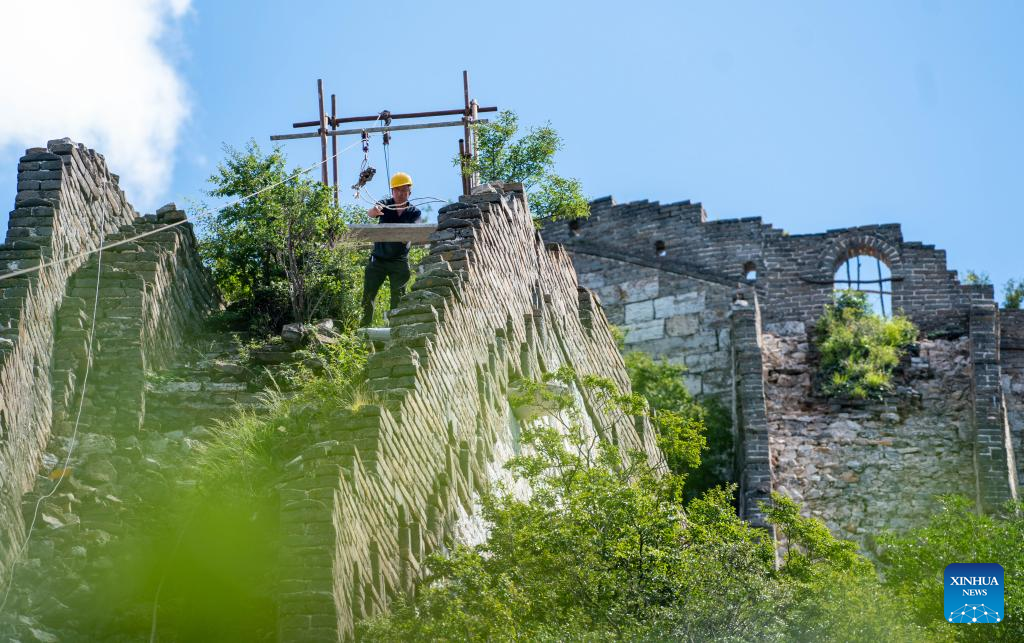
A worker is seen at the west part of the Jiankou section of the Great Wall in Beijing, capital of China, Aug. 16, 2022. Located in Beijing's suburban Huairou District, the Jiankou section of the Great Wall, once known among the hikers as "the deserted Great Wall", is believed to be one of the most dangerous parts of the relic.
A restoration project, mainly focusing on a 1,678-meter-long wall with 8 watchtowers in the west part of Jiankou section, is expected to be completed by the end of October.
The project is implemented in adherence of the principle of "minimum intervention" to ensure maximum authenticity, integrity and ancient historical features of the Great Wall.
Meanwhile, a research-based restoration project is also underway with the aim of reinforcing and eliminating potential safety hazards as well as changes and existing conditions of the Great Wall through multidisciplinary cooperation. (Xinhua/Li Jing)
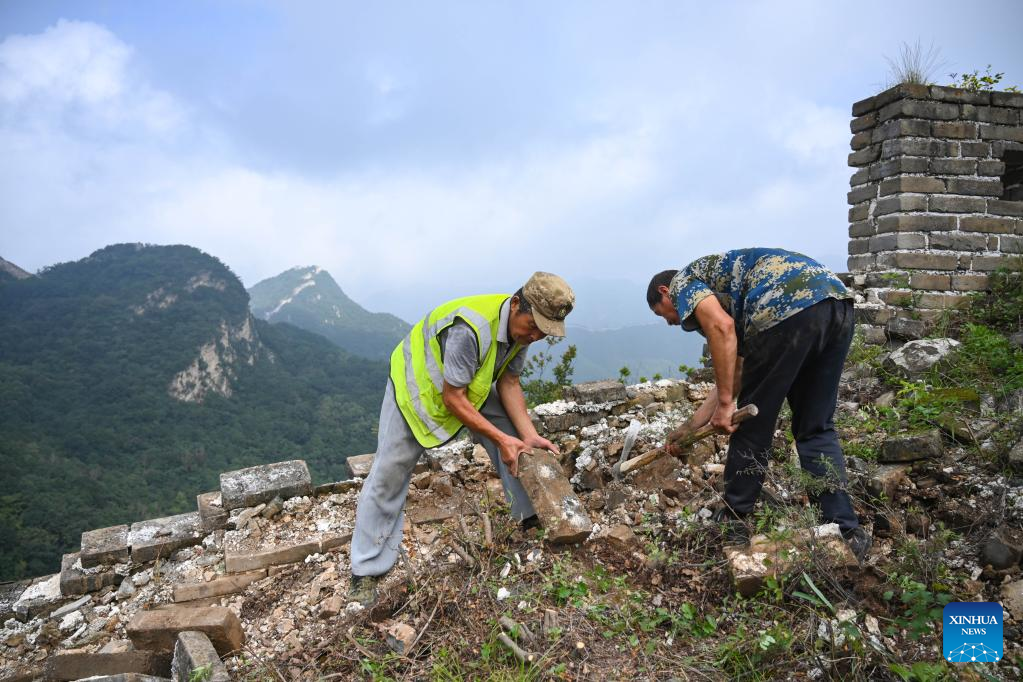
Workers work at an archeological site of the research-based restoration part of the Jiankou section of the Great Wall in Beijing, capital of China, Aug. 17, 2022. Located in Beijing's suburban Huairou District, the Jiankou section of the Great Wall, once known among the hikers as "the deserted Great Wall", is believed to be one of the most dangerous parts of the relic.
A restoration project, mainly focusing on a 1,678-meter-long wall with 8 watchtowers in the west part of Jiankou section, is expected to be completed by the end of October.
The project is implemented in adherence of the principle of "minimum intervention" to ensure maximum authenticity, integrity and ancient historical features of the Great Wall.
Meanwhile, a research-based restoration project is also underway with the aim of reinforcing and eliminating potential safety hazards as well as changes and existing conditions of the Great Wall through multidisciplinary cooperation. (Xinhua/Chen Yehua)
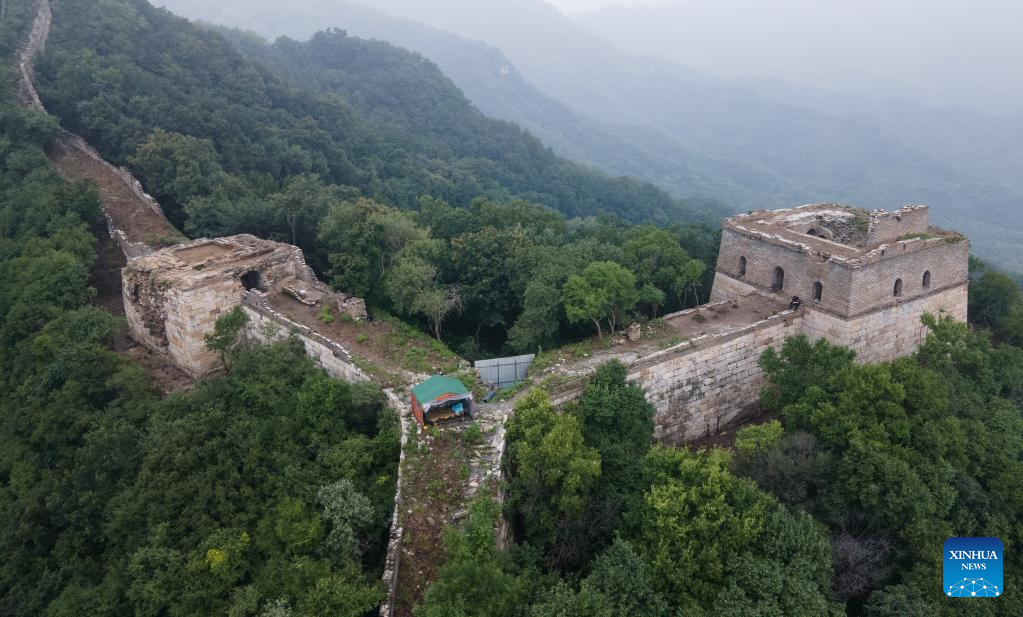
Photo taken on Aug. 17, 2022 shows an all weather archaeological site at the research-based renovation part of Jiankou section of the Great Wall in Beijing, capital of China. Located in Beijing's suburban Huairou District, the Jiankou section of the Great Wall, once known among the hikers as "the deserted Great Wall", is believed to be one of the most dangerous parts of the relic.
A restoration project, mainly focusing on a 1,678-meter-long wall with 8 watchtowers in the west part of Jiankou section, is expected to be completed by the end of October.
The project is implemented in adherence of the principle of "minimum intervention" to ensure maximum authenticity, integrity and ancient historical features of the Great Wall.
Meanwhile, a research-based restoration project is also underway with the aim of reinforcing and eliminating potential safety hazards as well as changes and existing conditions of the Great Wall through multidisciplinary cooperation. (Xinhua/Chen Zhonghao)
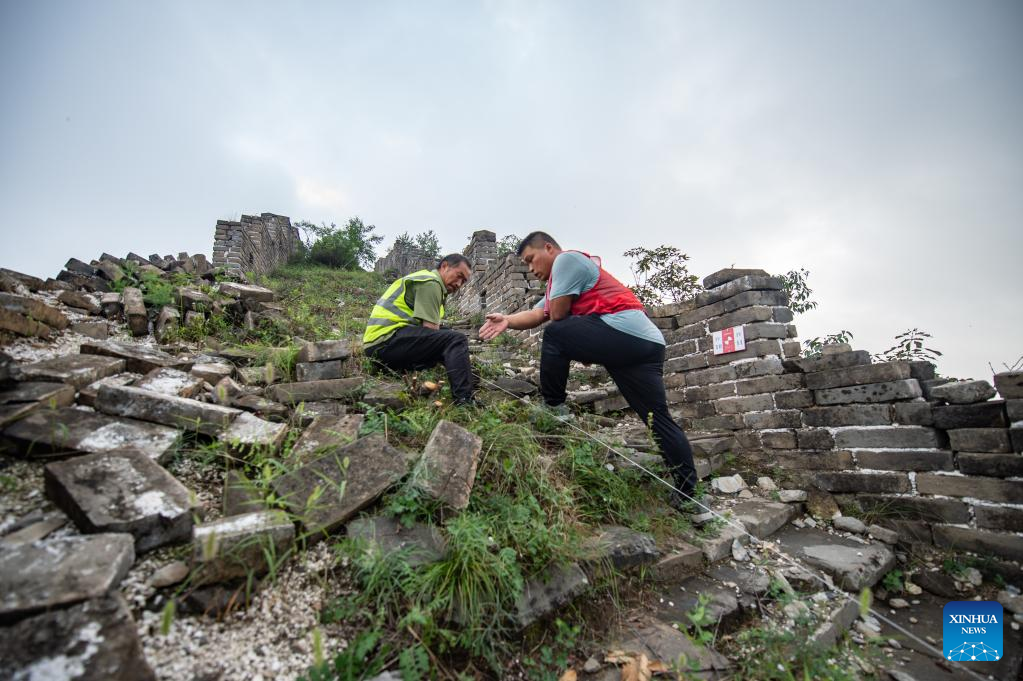
Technician Yang Zhanjie (R) and his colleague set up a boundary line around the archaeological excavations area at the research-based renovation part of Jiankou section of the Great Wall in Beijing, capital of China, Aug. 17, 2022. Located in Beijing's suburban Huairou District, the Jiankou section of the Great Wall, once known among the hikers as "the deserted Great Wall", is believed to be one of the most dangerous parts of the relic.
A restoration project, mainly focusing on a 1,678-meter-long wall with 8 watchtowers in the west part of Jiankou section, is expected to be completed by the end of October.
The project is implemented in adherence of the principle of "minimum intervention" to ensure maximum authenticity, integrity and ancient historical features of the Great Wall.
Meanwhile, a research-based restoration project is also underway with the aim of reinforcing and eliminating potential safety hazards as well as changes and existing conditions of the Great Wall through multidisciplinary cooperation. (Xinhua/Chen Zhonghao)
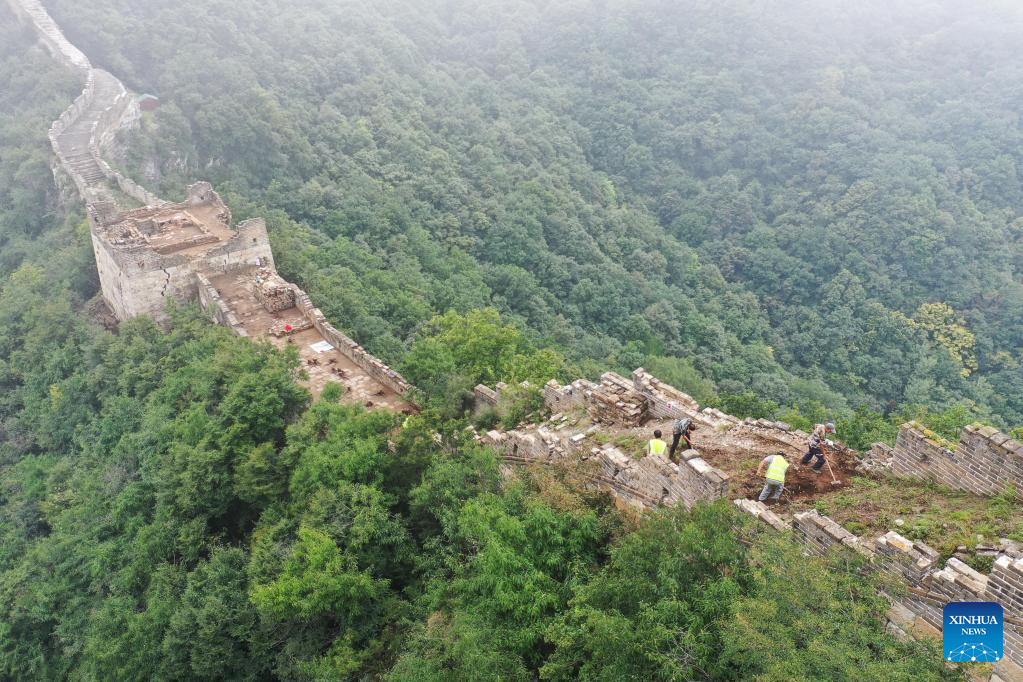
Aerial photo shows workers at an archaeological site at the research-based renovation part of Jiankou section of the Great Wall in Beijing, capital of China, Aug. 17, 2022. Located in Beijing's suburban Huairou District, the Jiankou section of the Great Wall, once known among the hikers as "the deserted Great Wall", is believed to be one of the most dangerous parts of the relic.
A restoration project, mainly focusing on a 1,678-meter-long wall with 8 watchtowers in the west part of Jiankou section, is expected to be completed by the end of October.
The project is implemented in adherence of the principle of "minimum intervention" to ensure maximum authenticity, integrity and ancient historical features of the Great Wall.
Meanwhile, a research-based restoration project is also underway with the aim of reinforcing and eliminating potential safety hazards as well as changes and existing conditions of the Great Wall through multidisciplinary cooperation. (Xinhua/Chen Yehua)
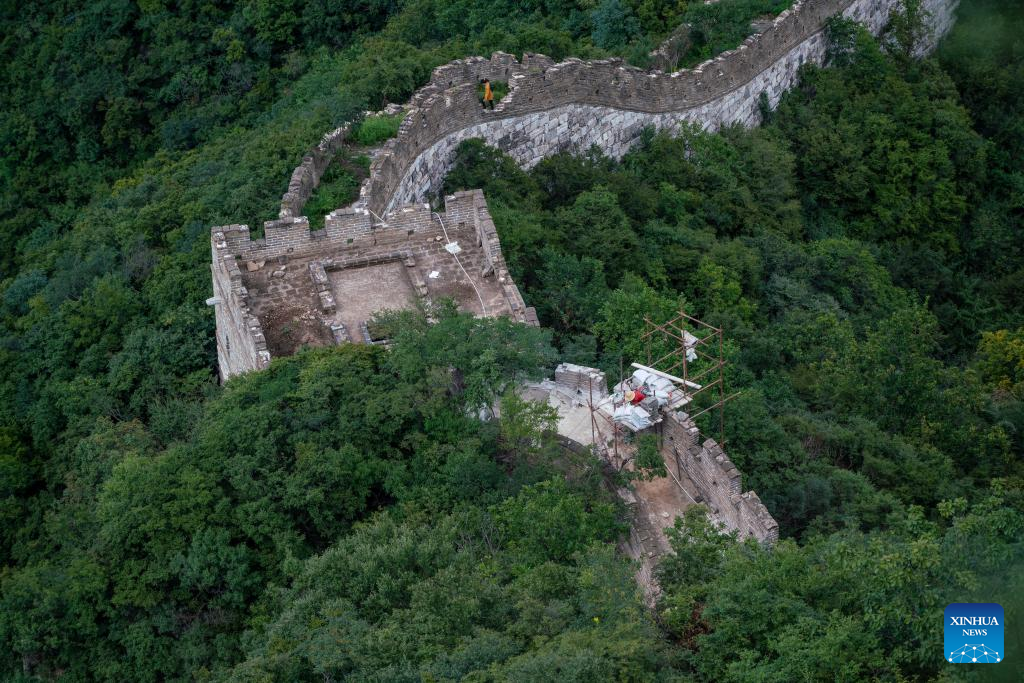
Workers are seen at the west part of the Jiankou section of the Great Wall in Beijing, capital of China, Aug. 16, 2022. Located in Beijing's suburban Huairou District, the Jiankou section of the Great Wall, once known among the hikers as "the deserted Great Wall", is believed to be one of the most dangerous parts of the relic.
A restoration project, mainly focusing on a 1,678-meter-long wall with 8 watchtowers in the west part of Jiankou section, is expected to be completed by the end of October.
The project is implemented in adherence of the principle of "minimum intervention" to ensure maximum authenticity, integrity and ancient historical features of the Great Wall.
Meanwhile, a research-based restoration project is also underway with the aim of reinforcing and eliminating potential safety hazards as well as changes and existing conditions of the Great Wall through multidisciplinary cooperation. (Xinhua/Li Jing)
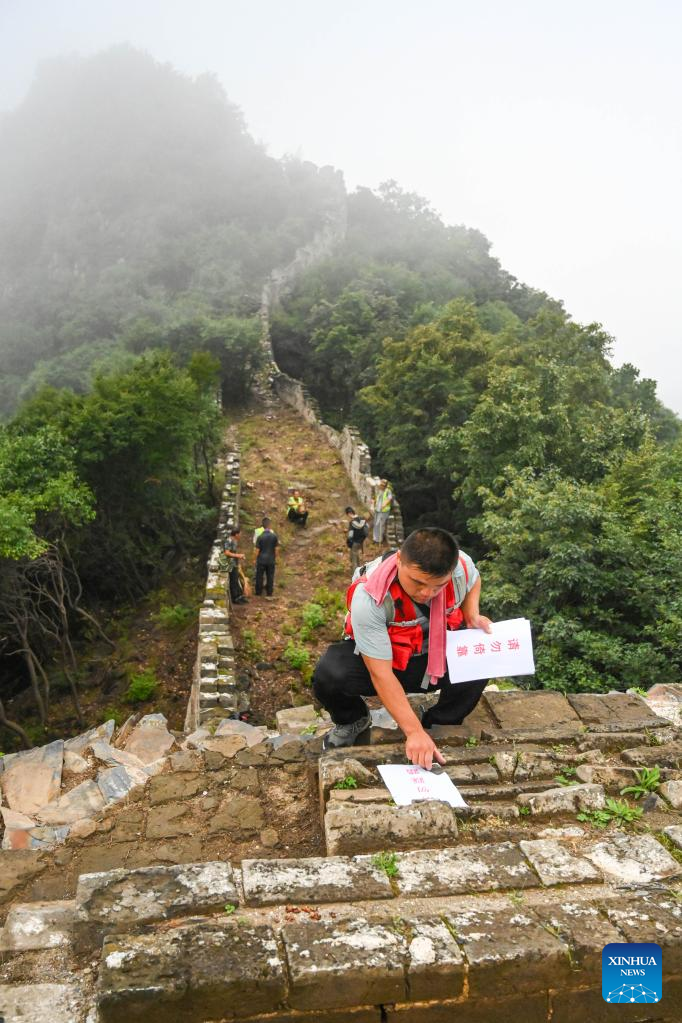
Technician Yang Zhanjie places a caution reminder on a collapsed wall of a watchtower to prevent people from trampling at the research-based renovation part of Jiankou section of the Great Wall in Beijing, capital of China, Aug. 17, 2022. Located in Beijing's suburban Huairou District, the Jiankou section of the Great Wall, once known among the hikers as "the deserted Great Wall", is believed to be one of the most dangerous parts of the relic.
A restoration project, mainly focusing on a 1,678-meter-long wall with 8 watchtowers in the west part of Jiankou section, is expected to be completed by the end of October.
The project is implemented in adherence of the principle of "minimum intervention" to ensure maximum authenticity, integrity and ancient historical features of the Great Wall.
Meanwhile, a research-based restoration project is also underway with the aim of reinforcing and eliminating potential safety hazards as well as changes and existing conditions of the Great Wall through multidisciplinary cooperation. (Xinhua/Chen Yehua)

A worker cleans the Great Wall where some roots of trees cut after natural damages are intentionaly left for further biological research at the Jiankou section of the Great Wall in Beijing, capital of China, Aug. 17, 2022. Located in Beijing's suburban Huairou District, the Jiankou section of the Great Wall, once known among the hikers as "the deserted Great Wall", is believed to be one of the most dangerous parts of the relic.
A restoration project, mainly focusing on a 1,678-meter-long wall with 8 watchtowers in the west part of Jiankou section, is expected to be completed by the end of October.
The project is implemented in adherence of the principle of "minimum intervention" to ensure maximum authenticity, integrity and ancient historical features of the Great Wall.
Meanwhile, a research-based restoration project is also underway with the aim of reinforcing and eliminating potential safety hazards as well as changes and existing conditions of the Great Wall through multidisciplinary cooperation. (Xinhua/Li Jing)
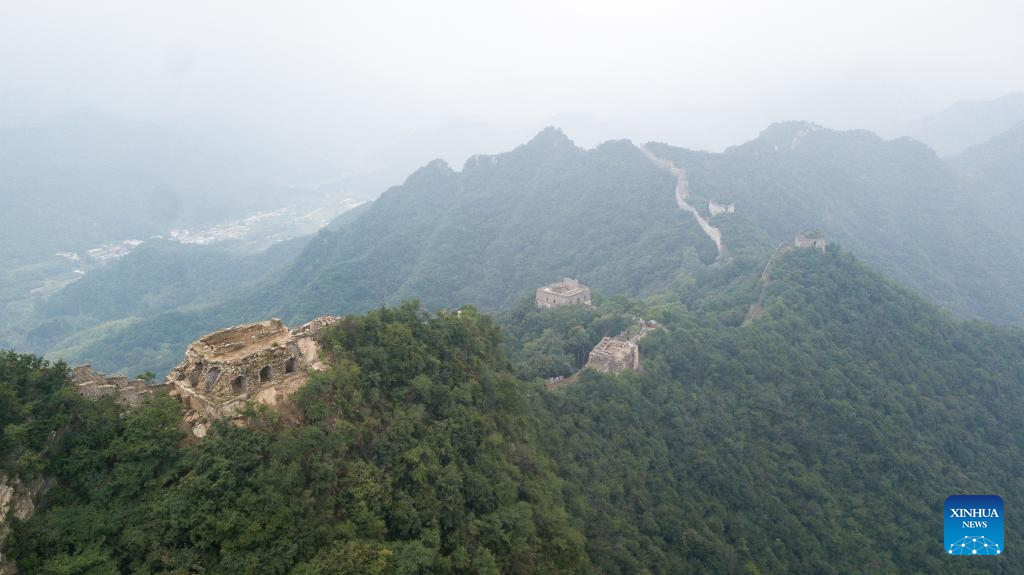
Aerial photo taken on Aug. 17, 2022 shows watchtowers at the research-based restoration part at Jiankou section of the Great Wall in Beijing, capital of China. Located in Beijing's suburban Huairou District, the Jiankou section of the Great Wall, once known among the hikers as "the deserted Great Wall", is believed to be one of the most dangerous parts of the relic.
A restoration project, mainly focusing on a 1,678-meter-long wall with 8 watchtowers in the west part of Jiankou section, is expected to be completed by the end of October.
The project is implemented in adherence of the principle of "minimum intervention" to ensure maximum authenticity, integrity and ancient historical features of the Great Wall.
Meanwhile, a research-based restoration project is also underway with the aim of reinforcing and eliminating potential safety hazards as well as changes and existing conditions of the Great Wall through multidisciplinary cooperation. (Xinhua/Li Jing)
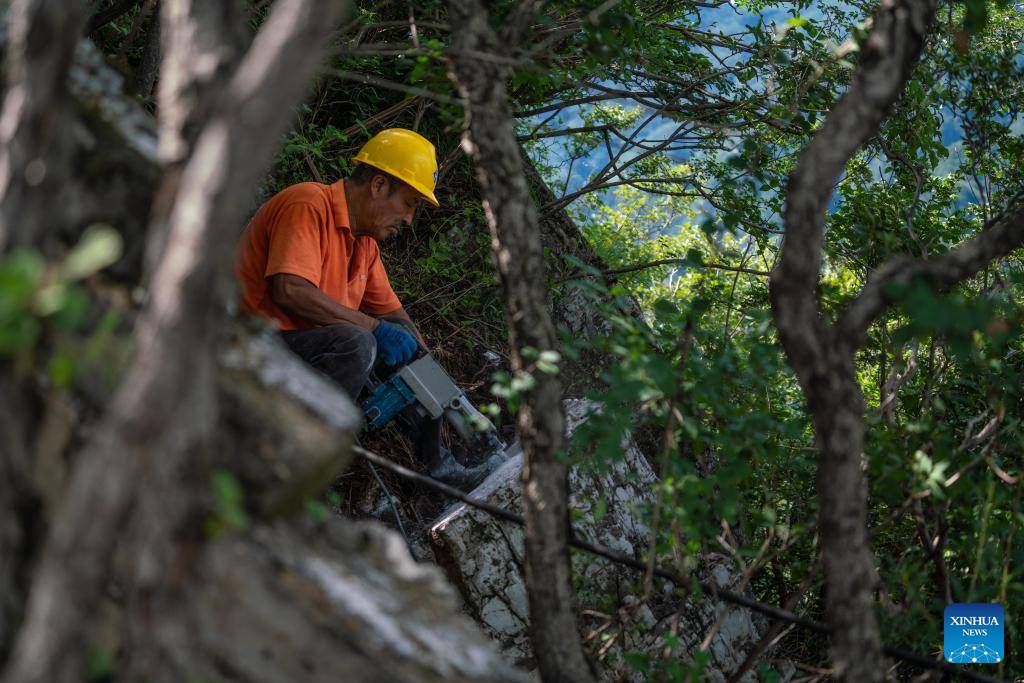
A worker collects stones from the mountain as material for restoration at the west part of the Jiankou section of the Great Wall in Beijing, capital of China, Aug. 16, 2022. Located in Beijing's suburban Huairou District, the Jiankou section of the Great Wall, once known among the hikers as "the deserted Great Wall", is believed to be one of the most dangerous parts of the relic.
A restoration project, mainly focusing on a 1,678-meter-long wall with 8 watchtowers in the west part of Jiankou section, is expected to be completed by the end of October.
The project is implemented in adherence of the principle of "minimum intervention" to ensure maximum authenticity, integrity and ancient historical features of the Great Wall.
Meanwhile, a research-based restoration project is also underway with the aim of reinforcing and eliminating potential safety hazards as well as changes and existing conditions of the Great Wall through multidisciplinary cooperation. (Xinhua/Li Jing)
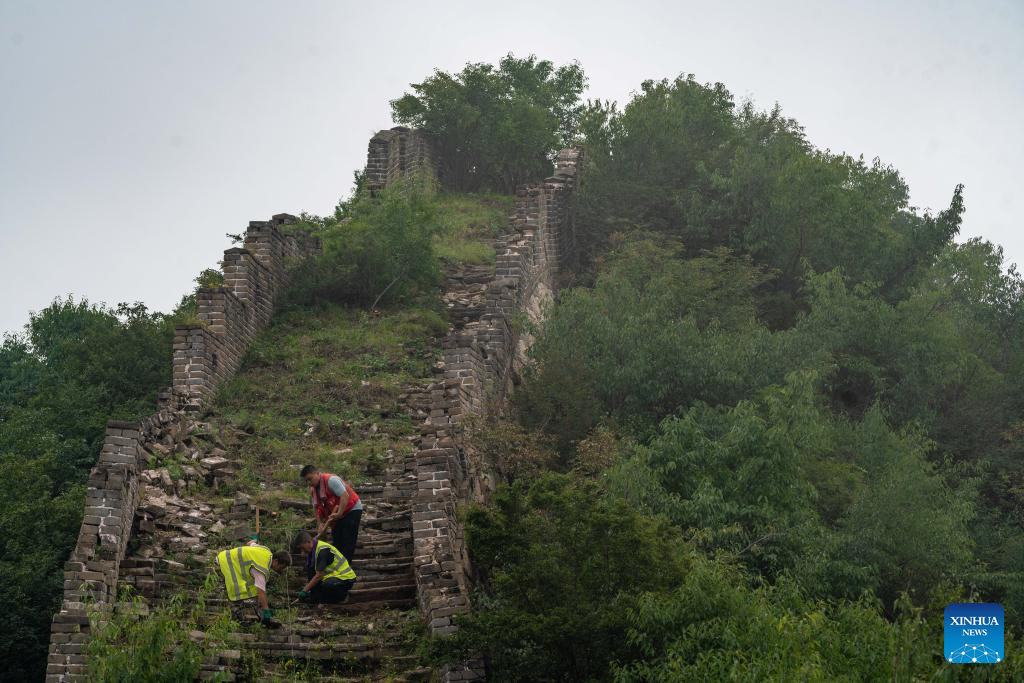
Workers work at the archeological excavation site at the research-based restoration part at Jiankou section of the Great Wall in Beijing, capital of China, Aug. 17, 2022. Located in Beijing's suburban Huairou District, the Jiankou section of the Great Wall, once known among the hikers as "the deserted Great Wall", is believed to be one of the most dangerous parts of the relic.
A restoration project, mainly focusing on a 1,678-meter-long wall with 8 watchtowers in the west part of Jiankou section, is expected to be completed by the end of October.
The project is implemented in adherence of the principle of "minimum intervention" to ensure maximum authenticity, integrity and ancient historical features of the Great Wall.
Meanwhile, a research-based restoration project is also underway with the aim of reinforcing and eliminating potential safety hazards as well as changes and existing conditions of the Great Wall through multidisciplinary cooperation. (Xinhua/Li Jing)
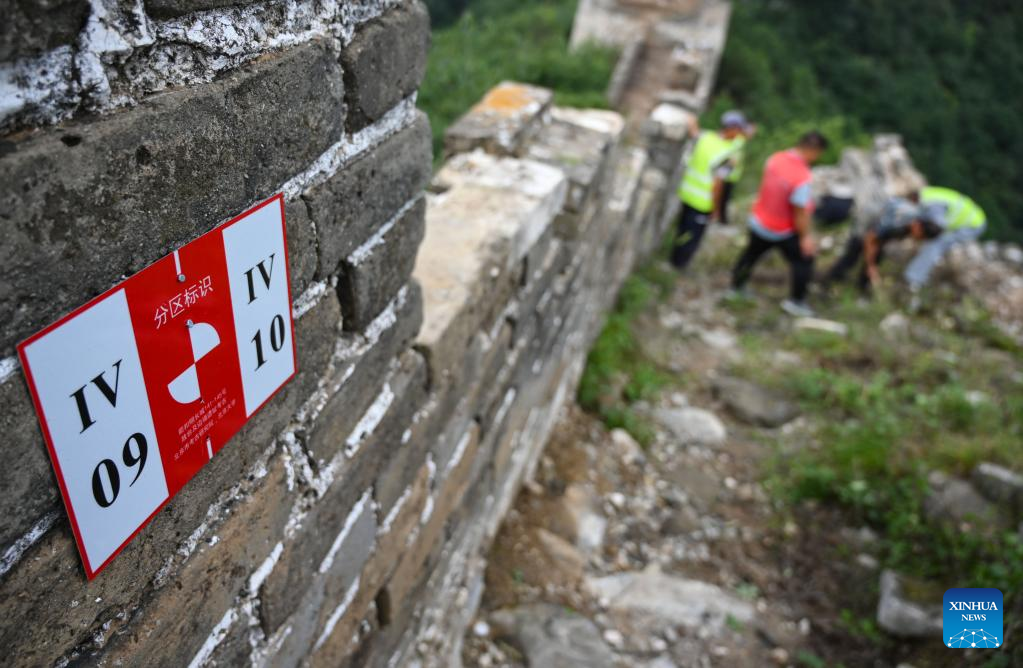
Workers work at an archeological site of the research-based restoration part of the Jiankou section of the Great Wall in Beijing, capital of China, Aug. 17, 2022. Located in Beijing's suburban Huairou District, the Jiankou section of the Great Wall, once known among the hikers as "the deserted Great Wall", is believed to be one of the most dangerous parts of the relic.
A restoration project, mainly focusing on a 1,678-meter-long wall with 8 watchtowers in the west part of Jiankou section, is expected to be completed by the end of October.
The project is implemented in adherence of the principle of "minimum intervention" to ensure maximum authenticity, integrity and ancient historical features of the Great Wall.
Meanwhile, a research-based restoration project is also underway with the aim of reinforcing and eliminating potential safety hazards as well as changes and existing conditions of the Great Wall through multidisciplinary cooperation. (Xinhua/Chen Yehua)
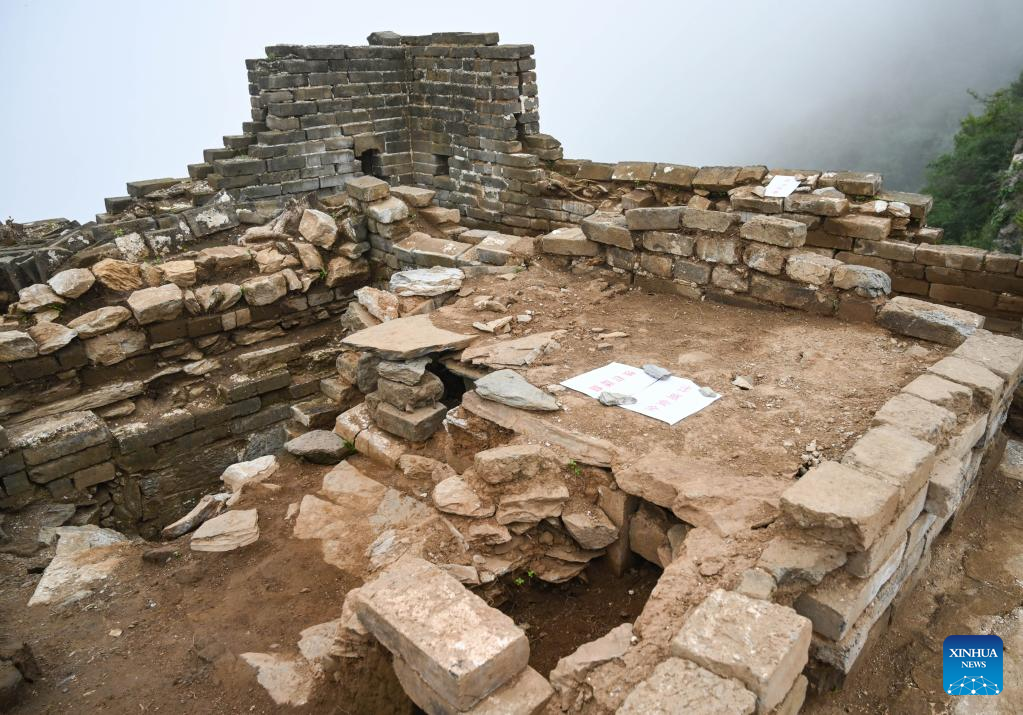
Photo taken on Aug. 17, 2022 shows an archeological site of the research-based restoration part of the Jiankou section of the Great Wall in Beijing, capital of China. Located in Beijing's suburban Huairou District, the Jiankou section of the Great Wall, once known among the hikers as "the deserted Great Wall", is believed to be one of the most dangerous parts of the relic.
A restoration project, mainly focusing on a 1,678-meter-long wall with 8 watchtowers in the west part of Jiankou section, is expected to be completed by the end of October.
The project is implemented in adherence of the principle of "minimum intervention" to ensure maximum authenticity, integrity and ancient historical features of the Great Wall.
Meanwhile, a research-based restoration project is also underway with the aim of reinforcing and eliminating potential safety hazards as well as changes and existing conditions of the Great Wall through multidisciplinary cooperation. (Xinhua/Chen Yehua)
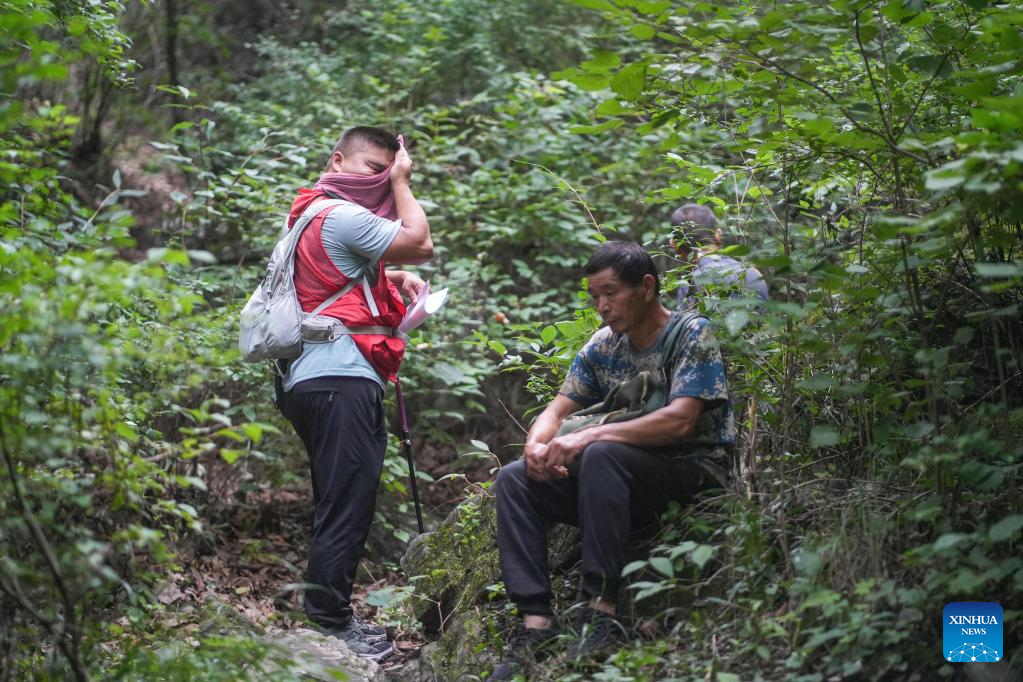
Technician Yang Zhanjie (L) and his colleagues take a rest on the way towards the Jiankou section of the Great Wall in Beijing, capital of China, Aug. 17, 2022. Located in Beijing's suburban Huairou District, the Jiankou section of the Great Wall, once known among the hikers as "the deserted Great Wall", is believed to be one of the most dangerous parts of the relic.
A restoration project, mainly focusing on a 1,678-meter-long wall with 8 watchtowers in the west part of Jiankou section, is expected to be completed by the end of October.
The project is implemented in adherence of the principle of "minimum intervention" to ensure maximum authenticity, integrity and ancient historical features of the Great Wall.
Meanwhile, a research-based restoration project is also underway with the aim of reinforcing and eliminating potential safety hazards as well as changes and existing conditions of the Great Wall through multidisciplinary cooperation. (Xinhua/Chen Yehua)
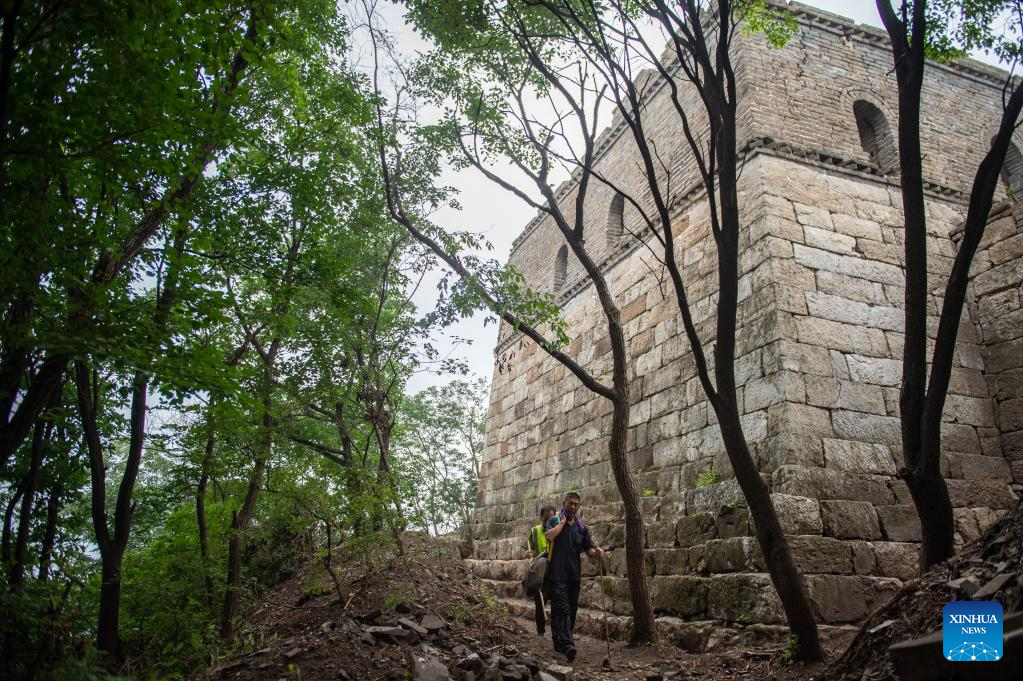
Workers pass by an archaeological site of the research-based renovation part of Jiankou section of the Great Wall in Beijing, capital of China, Aug. 17, 2022. Located in Beijing's suburban Huairou District, the Jiankou section of the Great Wall, once known among the hikers as "the deserted Great Wall", is believed to be one of the most dangerous parts of the relic.
A restoration project, mainly focusing on a 1,678-meter-long wall with 8 watchtowers in the west part of Jiankou section, is expected to be completed by the end of October.
The project is implemented in adherence of the principle of "minimum intervention" to ensure maximum authenticity, integrity and ancient historical features of the Great Wall.
Meanwhile, a research-based restoration project is also underway with the aim of reinforcing and eliminating potential safety hazards as well as changes and existing conditions of the Great Wall through multidisciplinary cooperation. (Xinhua/Chen Zhonghao)
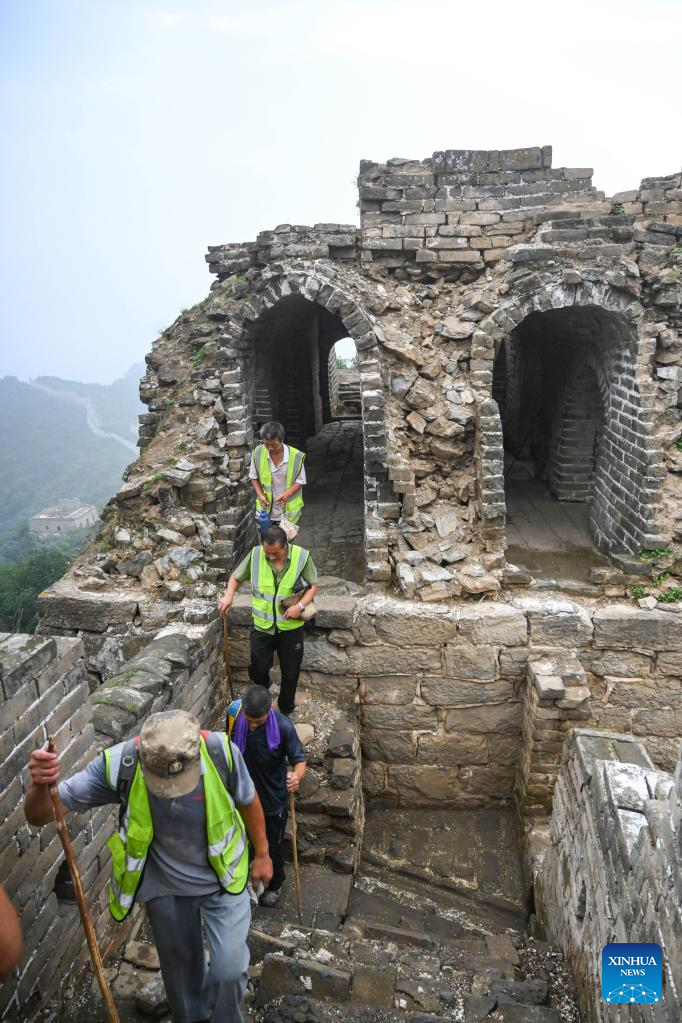
Workers pass watchtower No. 144 at the research-based renovation part of Jiankou section of the Great Wall in Beijing, capital of China, Aug. 17, 2022. Located in Beijing's suburban Huairou District, the Jiankou section of the Great Wall, once known among the hikers as "the deserted Great Wall", is believed to be one of the most dangerous parts of the relic.
A restoration project, mainly focusing on a 1,678-meter-long wall with 8 watchtowers in the west part of Jiankou section, is expected to be completed by the end of October.
The project is implemented in adherence of the principle of "minimum intervention" to ensure maximum authenticity, integrity and ancient historical features of the Great Wall.
Meanwhile, a research-based restoration project is also underway with the aim of reinforcing and eliminating potential safety hazards as well as changes and existing conditions of the Great Wall through multidisciplinary cooperation. (Xinhua/Chen Yehua)
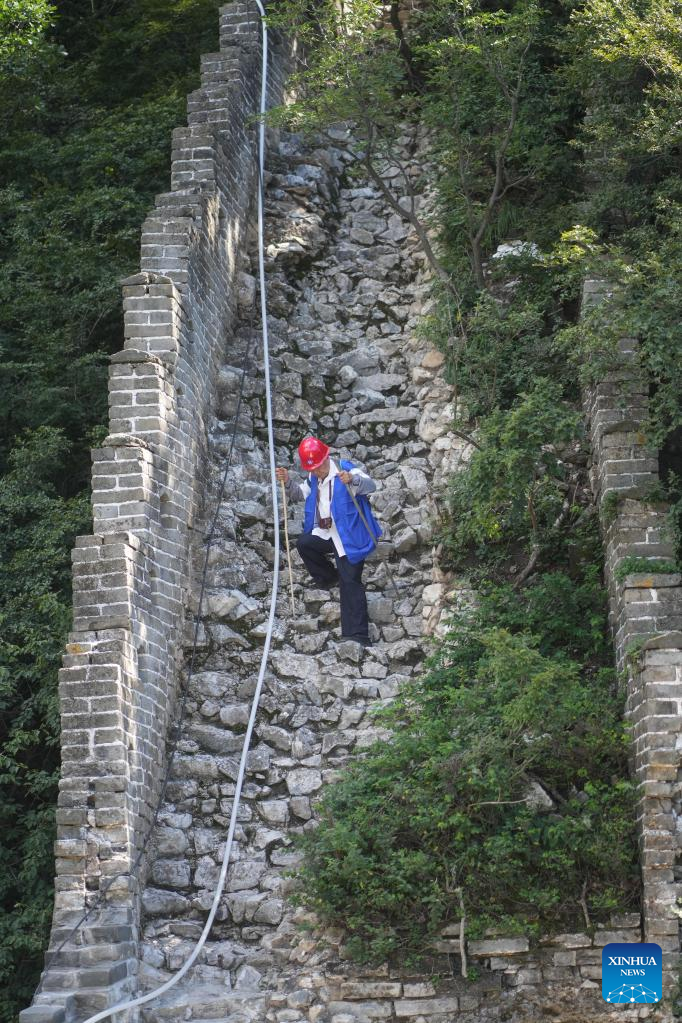
Engineer Cheng Yongmao is on the way towards a restoration site of the west part of the Jiankou section of the Great Wall in Beijing, capital of China, Aug. 16, 2022. Located in Beijing's suburban Huairou District, the Jiankou section of the Great Wall, once known among the hikers as "the deserted Great Wall", is believed to be one of the most dangerous parts of the relic.
A restoration project, mainly focusing on a 1,678-meter-long wall with 8 watchtowers in the west part of Jiankou section, is expected to be completed by the end of October.
The project is implemented in adherence of the principle of "minimum intervention" to ensure maximum authenticity, integrity and ancient historical features of the Great Wall.
Meanwhile, a research-based restoration project is also underway with the aim of reinforcing and eliminating potential safety hazards as well as changes and existing conditions of the Great Wall through multidisciplinary cooperation. (Xinhua/Chen Yehua)
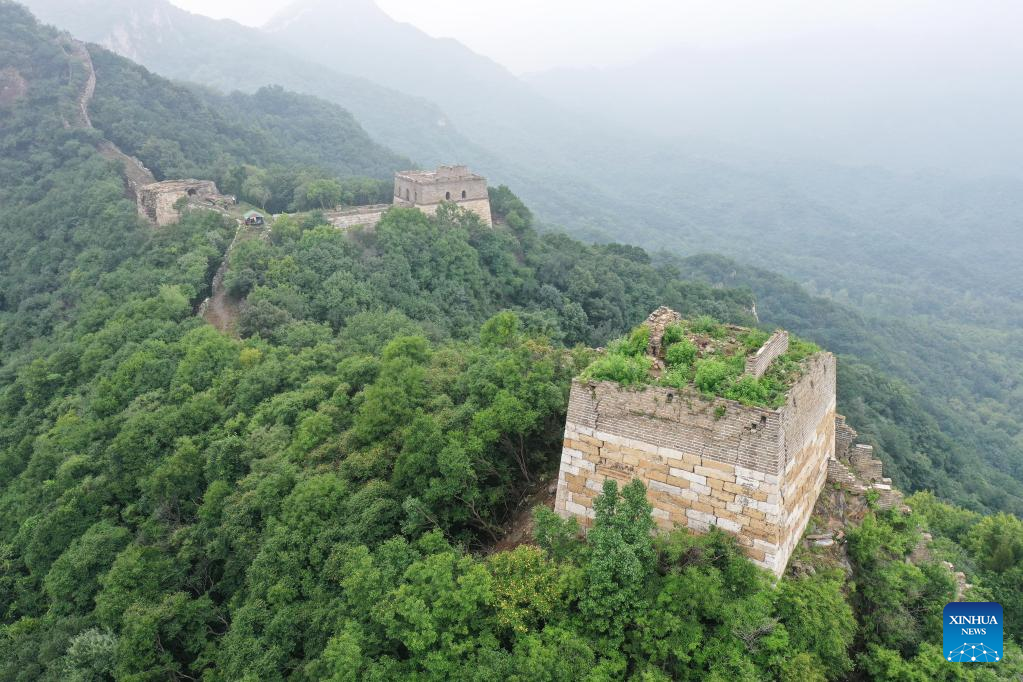
Aerial photo taken on Aug. 17, 2022 shows watchtowers of the research-based restoration part of the Jiankou section of the Great Wall in Beijing, capital of China. Located in Beijing's suburban Huairou District, the Jiankou section of the Great Wall, once known among the hikers as "the deserted Great Wall", is believed to be one of the most dangerous parts of the relic.
A restoration project, mainly focusing on a 1,678-meter-long wall with 8 watchtowers in the west part of Jiankou section, is expected to be completed by the end of October.
The project is implemented in adherence of the principle of "minimum intervention" to ensure maximum authenticity, integrity and ancient historical features of the Great Wall.
Meanwhile, a research-based restoration project is also underway with the aim of reinforcing and eliminating potential safety hazards as well as changes and existing conditions of the Great Wall through multidisciplinary cooperation. (Xinhua/Chen Yehua)
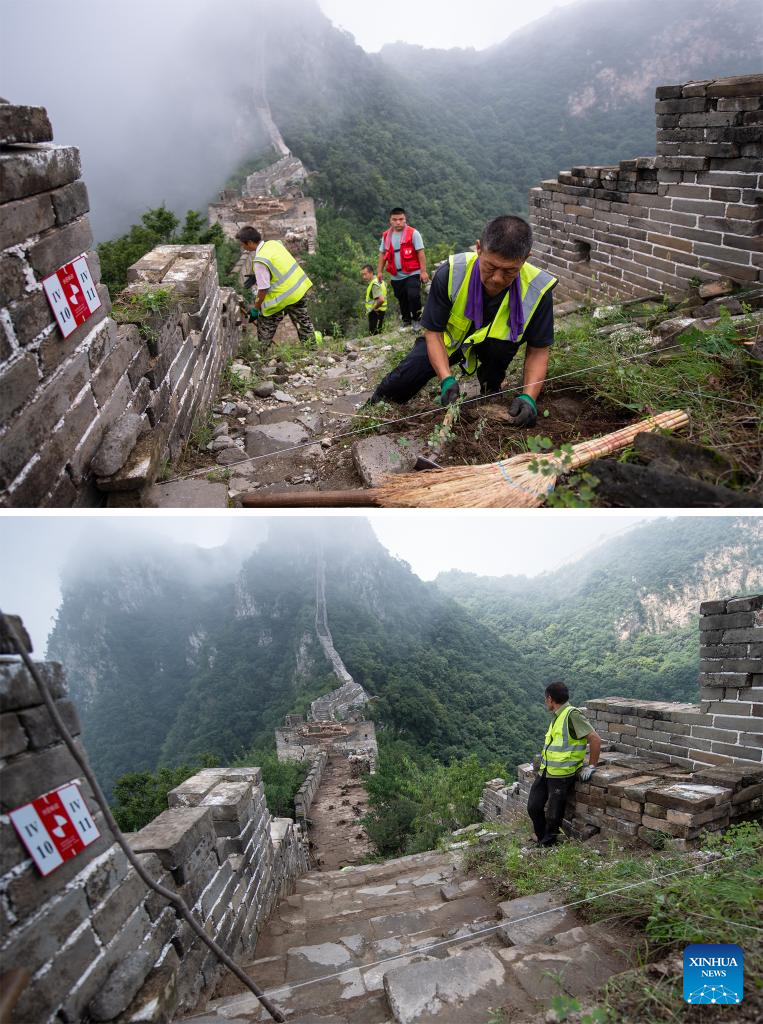
Combo photo shows workers at a archaeological site (upper) and workers collecting original bricks for later restoration after part of the archaeological work at the research-based renovation part of Jiankou section of the Great Wall in Beijing, capital of China, Aug. 17, 2022. Located in Beijing's suburban Huairou District, the Jiankou section of the Great Wall, once known among the hikers as "the deserted Great Wall", is believed to be one of the most dangerous parts of the relic.
A restoration project, mainly focusing on a 1,678-meter-long wall with 8 watchtowers in the west part of Jiankou section, is expected to be completed by the end of October.
The project is implemented in adherence of the principle of "minimum intervention" to ensure maximum authenticity, integrity and ancient historical features of the Great Wall.
Meanwhile, a research-based restoration project is also underway with the aim of reinforcing and eliminating potential safety hazards as well as changes and existing conditions of the Great Wall through multidisciplinary cooperation. (Xinhua/Chen Zhonghao)
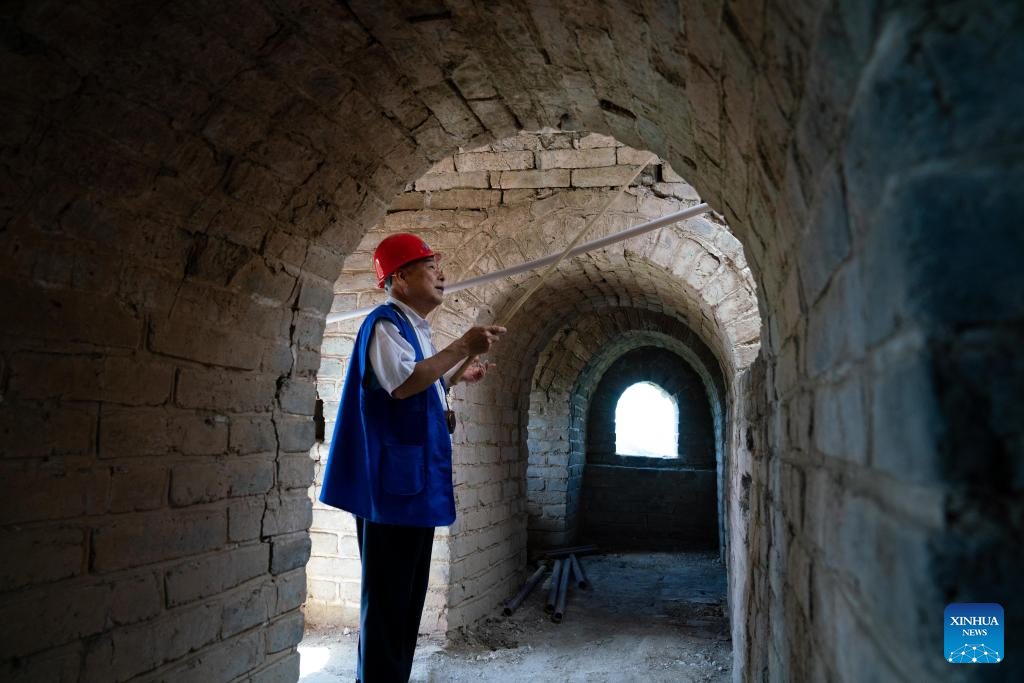
Engineer Cheng Yongmao inspects the watchtower No. 158 at the west part of the Jiankou section of the Great Wall in Beijing, capital of China, Aug. 16, 2022. Located in Beijing's suburban Huairou District, the Jiankou section of the Great Wall, once known among the hikers as "the deserted Great Wall", is believed to be one of the most dangerous parts of the relic.
A restoration project, mainly focusing on a 1,678-meter-long wall with 8 watchtowers in the west part of Jiankou section, is expected to be completed by the end of October.
The project is implemented in adherence of the principle of "minimum intervention" to ensure maximum authenticity, integrity and ancient historical features of the Great Wall.
Meanwhile, a research-based restoration project is also underway with the aim of reinforcing and eliminating potential safety hazards as well as changes and existing conditions of the Great Wall through multidisciplinary cooperation. (Xinhua/Li Jing)
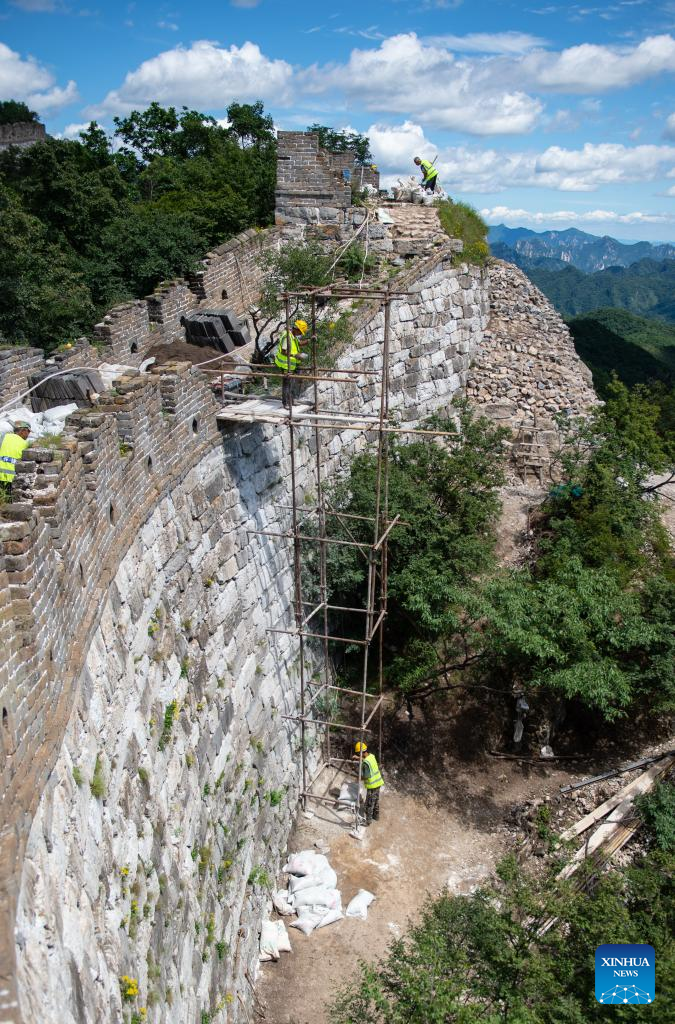
Workers use mechanical pulleys to carry construction materials to a restoration site of the west part of Jiankou section of the Great Wall in Beijing, capital of China, Aug. 16, 2022. Located in Beijing's suburban Huairou District, the Jiankou section of the Great Wall, once known among the hikers as "the deserted Great Wall", is believed to be one of the most dangerous parts of the relic.
A restoration project, mainly focusing on a 1,678-meter-long wall with 8 watchtowers in the west part of Jiankou section, is expected to be completed by the end of October.
The project is implemented in adherence of the principle of "minimum intervention" to ensure maximum authenticity, integrity and ancient historical features of the Great Wall.
Meanwhile, a research-based restoration project is also underway with the aim of reinforcing and eliminating potential safety hazards as well as changes and existing conditions of the Great Wall through multidisciplinary cooperation. (Xinhua/Chen Zhonghao)
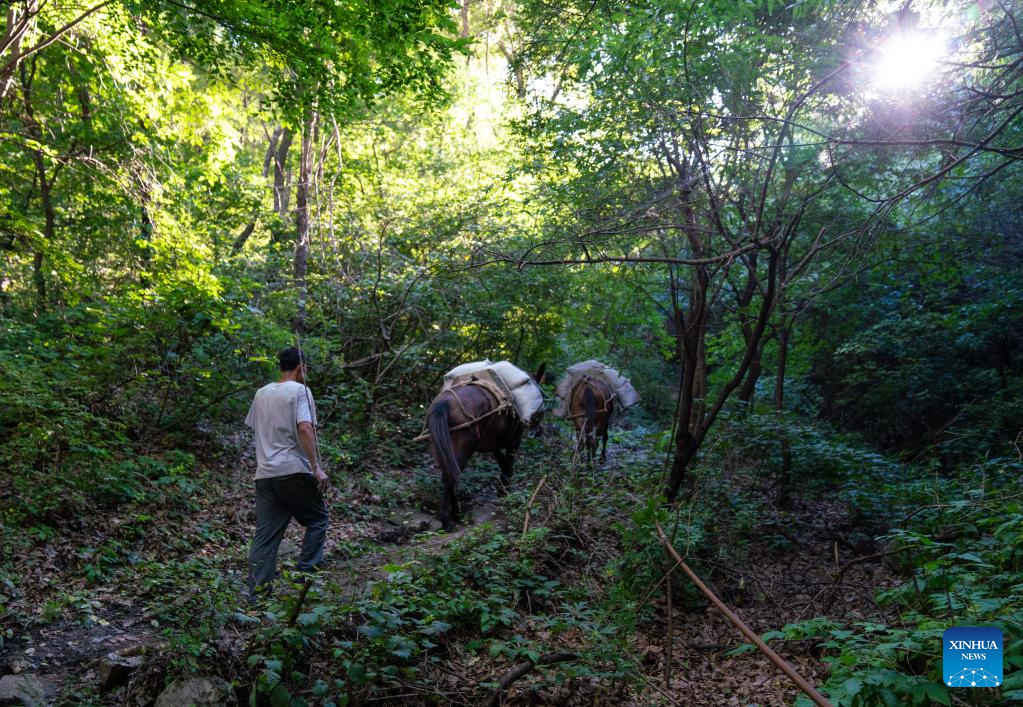
A worker monitors as materials are transported by livestock at the west part of the Jiankou section of the Great Wall in Beijing, capital of China, Aug. 16, 2022. Located in Beijing's suburban Huairou District, the Jiankou section of the Great Wall, once known among the hikers as "the deserted Great Wall", is believed to be one of the most dangerous parts of the relic.
A restoration project, mainly focusing on a 1,678-meter-long wall with 8 watchtowers in the west part of Jiankou section, is expected to be completed by the end of October.
The project is implemented in adherence of the principle of "minimum intervention" to ensure maximum authenticity, integrity and ancient historical features of the Great Wall.
Meanwhile, a research-based restoration project is also underway with the aim of reinforcing and eliminating potential safety hazards as well as changes and existing conditions of the Great Wall through multidisciplinary cooperation. (Xinhua/Li Jing)
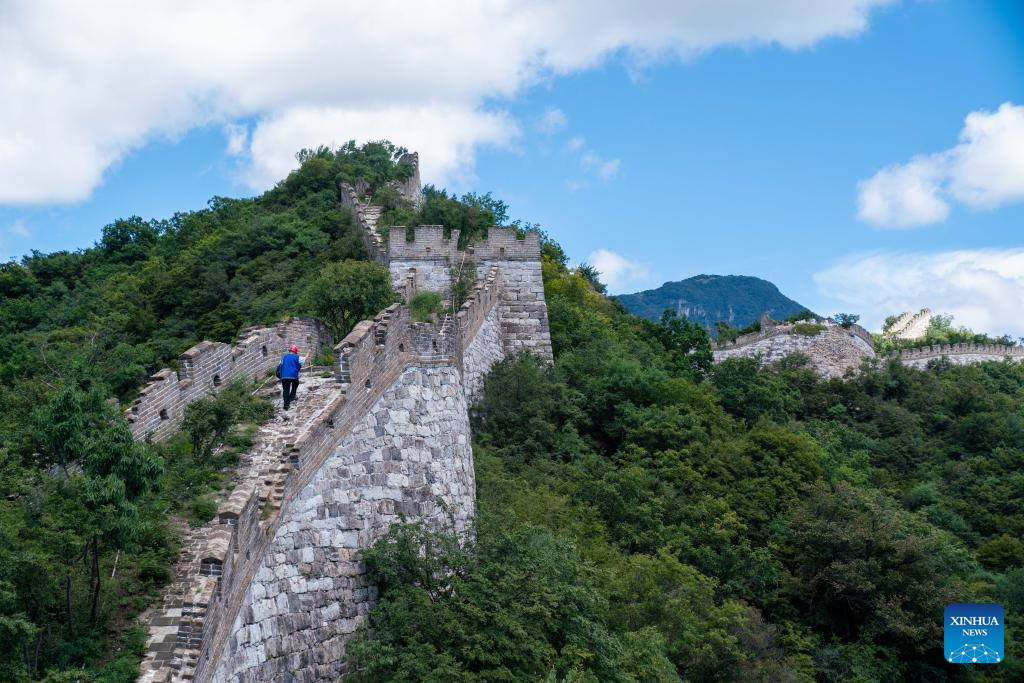
Engineer Cheng Yongmao walks on the west part of the Jiankou section of the Great Wall in Beijing, capital of China, Aug. 16, 2022. Located in Beijing's suburban Huairou District, the Jiankou section of the Great Wall, once known among the hikers as "the deserted Great Wall", is believed to be one of the most dangerous parts of the relic.
A restoration project, mainly focusing on a 1,678-meter-long wall with 8 watchtowers in the west part of Jiankou section, is expected to be completed by the end of October.
The project is implemented in adherence of the principle of "minimum intervention" to ensure maximum authenticity, integrity and ancient historical features of the Great Wall.
Meanwhile, a research-based restoration project is also underway with the aim of reinforcing and eliminating potential safety hazards as well as changes and existing conditions of the Great Wall through multidisciplinary cooperation. (Xinhua/Li Jing)
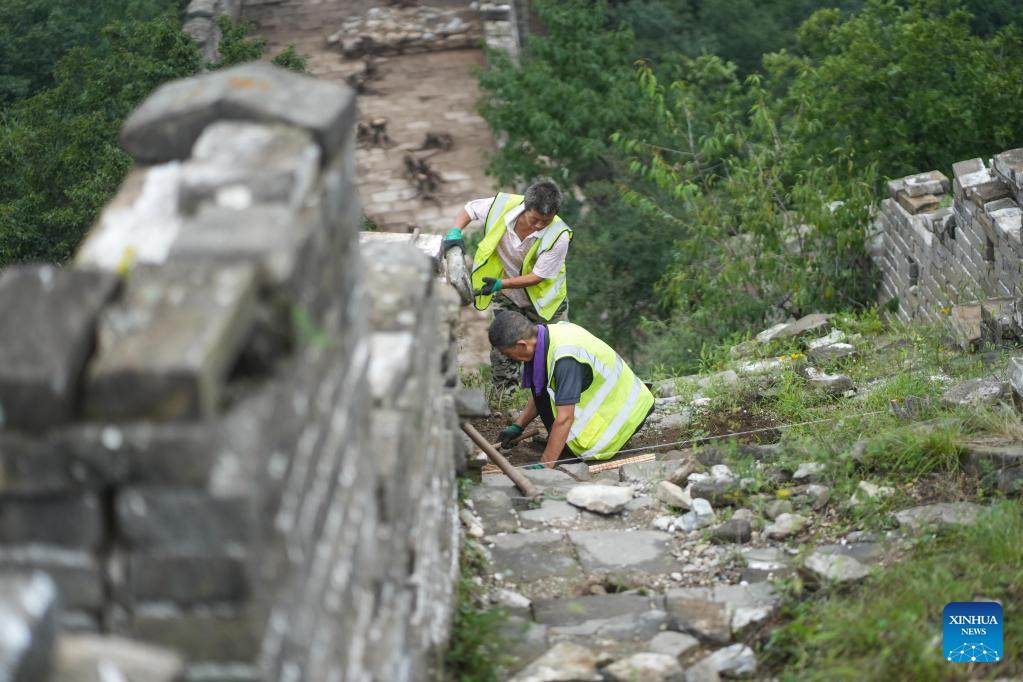
Workers work at an archeological site of the research-based restoration part of the Jiankou section of the Great Wall in Beijing, capital of China, Aug. 17, 2022. Located in Beijing's suburban Huairou District, the Jiankou section of the Great Wall, once known among the hikers as "the deserted Great Wall", is believed to be one of the most dangerous parts of the relic.
A restoration project, mainly focusing on a 1,678-meter-long wall with 8 watchtowers in the west part of Jiankou section, is expected to be completed by the end of October.
The project is implemented in adherence of the principle of "minimum intervention" to ensure maximum authenticity, integrity and ancient historical features of the Great Wall.
Meanwhile, a research-based restoration project is also underway with the aim of reinforcing and eliminating potential safety hazards as well as changes and existing conditions of the Great Wall through multidisciplinary cooperation. (Xinhua/Chen Yehua)
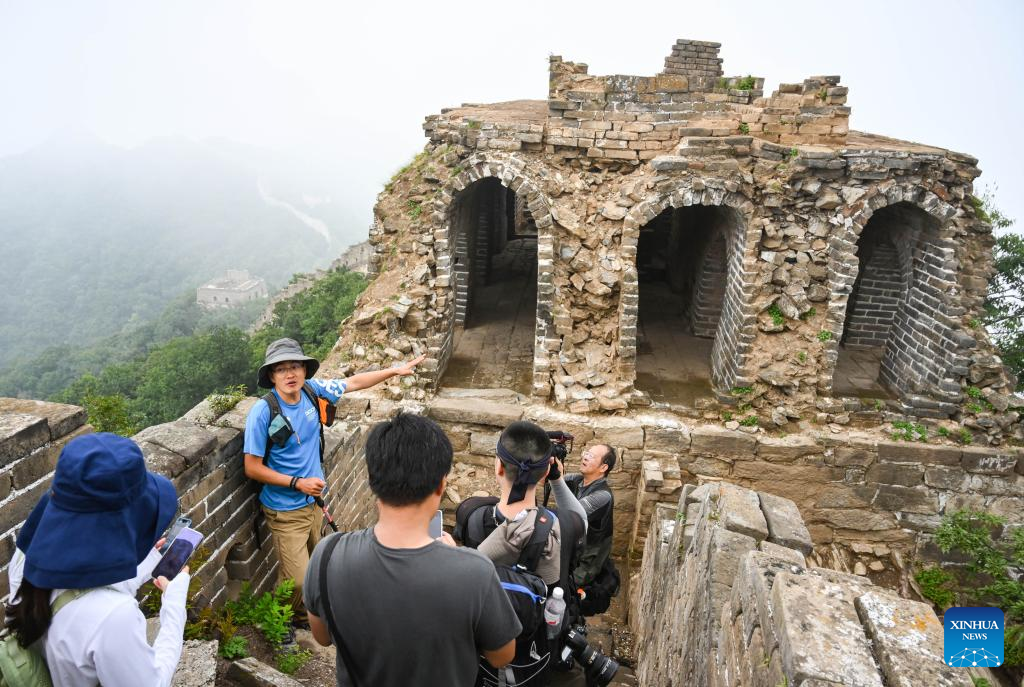
Researcher Shang Heng (2nd L) explains the features of a watchtower to the media at the research-based restoration part of the Jiankou section of the Great Wall in Beijing, capital of China, Aug. 17, 2022. Located in Beijing's suburban Huairou District, the Jiankou section of the Great Wall, once known among the hikers as "the deserted Great Wall", is believed to be one of the most dangerous parts of the relic.
A restoration project, mainly focusing on a 1,678-meter-long wall with 8 watchtowers in the west part of Jiankou section, is expected to be completed by the end of October.
The project is implemented in adherence of the principle of "minimum intervention" to ensure maximum authenticity, integrity and ancient historical features of the Great Wall.
Meanwhile, a research-based restoration project is also underway with the aim of reinforcing and eliminating potential safety hazards as well as changes and existing conditions of the Great Wall through multidisciplinary cooperation. (Xinhua/Chen Yehua)
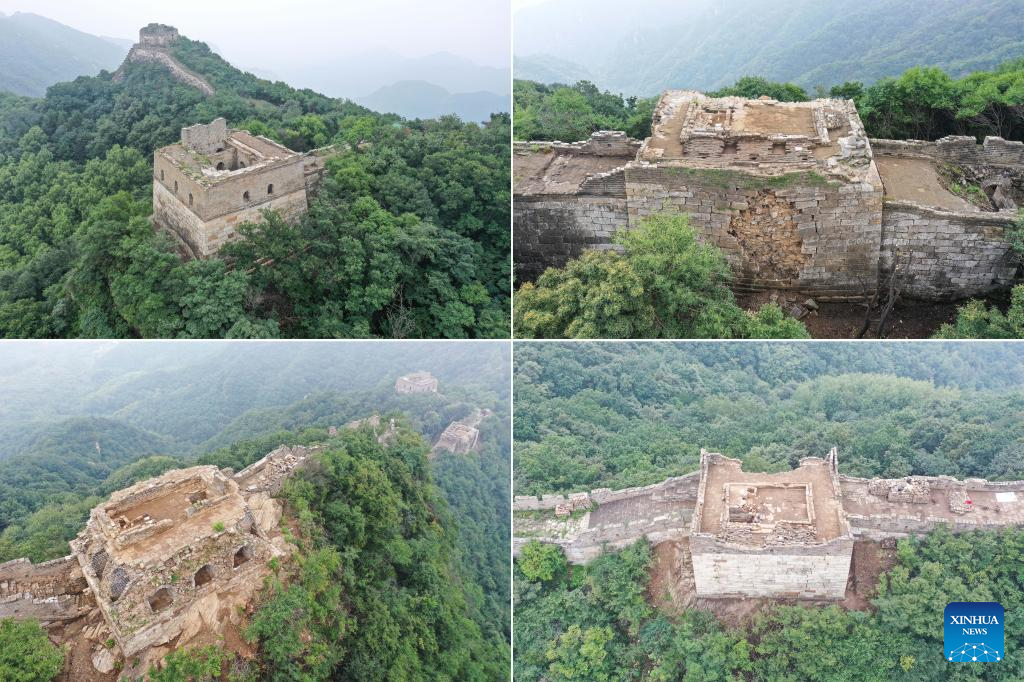
Combo aerial photo taken on Aug. 17, 2022 shows watchtower No. 142 under archaeological excavation (upper L), and watchtower No. 143 (upper R), No. 144 (lower L), and No. 145 (lower R) after archaeological excavations at the research-based renovation part of Jiankou section of the Great Wall in Beijing, capital of China. Located in Beijing's suburban Huairou District, the Jiankou section of the Great Wall, once known among the hikers as "the deserted Great Wall", is believed to be one of the most dangerous parts of the relic.
A restoration project, mainly focusing on a 1,678-meter-long wall with 8 watchtowers in the west part of Jiankou section, is expected to be completed by the end of October.
The project is implemented in adherence of the principle of "minimum intervention" to ensure maximum authenticity, integrity and ancient historical features of the Great Wall.
Meanwhile, a research-based restoration project is also underway with the aim of reinforcing and eliminating potential safety hazards as well as changes and existing conditions of the Great Wall through multidisciplinary cooperation. (Xinhua/Chen Yehua)
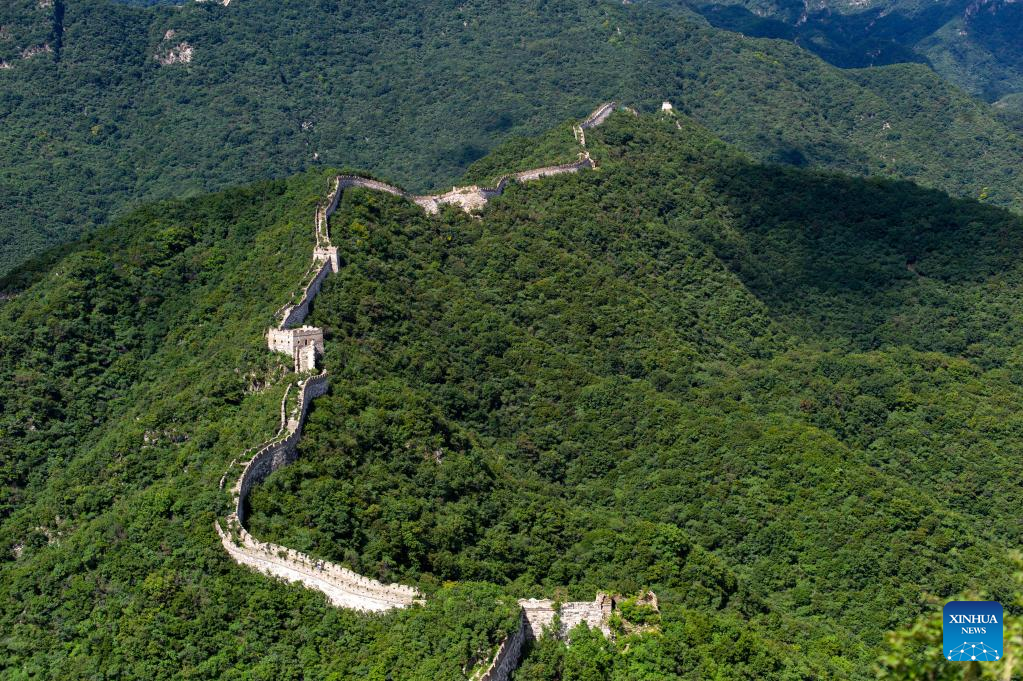
Photo taken on Aug. 16, 2022 shows the restoration site of the west part of Jiankou section of the Great Wall in Beijing, capital of China. Located in Beijing's suburban Huairou District, the Jiankou section of the Great Wall, once known among the hikers as "the deserted Great Wall", is believed to be one of the most dangerous parts of the relic.
A restoration project, mainly focusing on a 1,678-meter-long wall with 8 watchtowers in the west part of Jiankou section, is expected to be completed by the end of October.
The project is implemented in adherence of the principle of "minimum intervention" to ensure maximum authenticity, integrity and ancient historical features of the Great Wall.
Meanwhile, a research-based restoration project is also underway with the aim of reinforcing and eliminating potential safety hazards as well as changes and existing conditions of the Great Wall through multidisciplinary cooperation. (Xinhua/Li Jing)
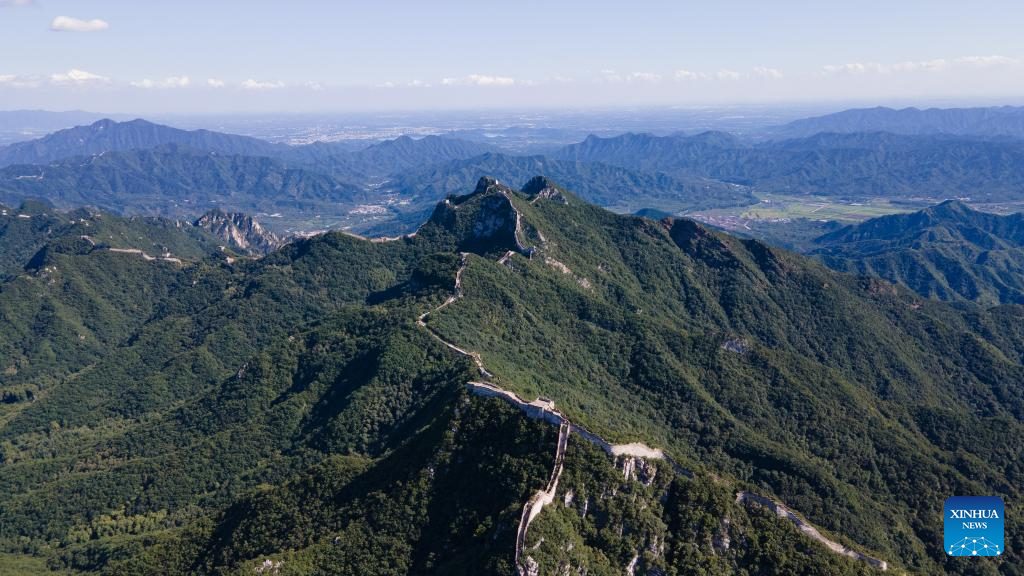
Aerial photo taken on Aug. 16, 2022 shows the scenic spot "Beijing Knot" and the west part of the Jiankou section of the Great Wall in Beijing, capital of China. Located in Beijing's suburban Huairou District, the Jiankou section of the Great Wall, once known among the hikers as "the deserted Great Wall", is believed to be one of the most dangerous parts of the relic.
A restoration project, mainly focusing on a 1,678-meter-long wall with 8 watchtowers in the west part of Jiankou section, is expected to be completed by the end of October.
The project is implemented in adherence of the principle of "minimum intervention" to ensure maximum authenticity, integrity and ancient historical features of the Great Wall.
Meanwhile, a research-based restoration project is also underway with the aim of reinforcing and eliminating potential safety hazards as well as changes and existing conditions of the Great Wall through multidisciplinary cooperation. (Xinhua/Chen Zhonghao)
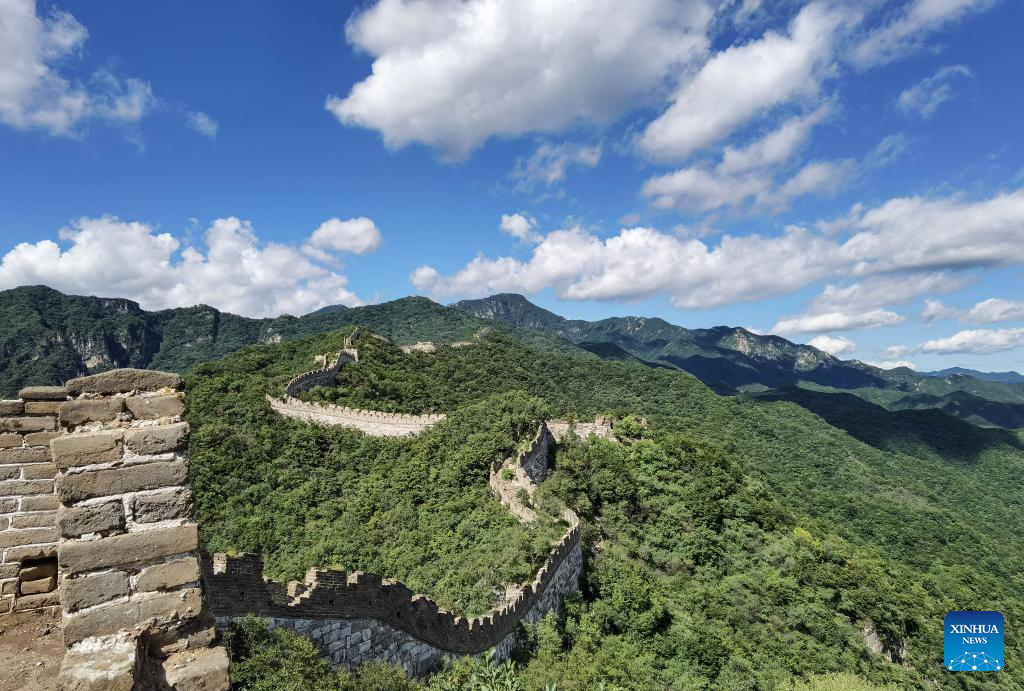
Photo taken on Aug. 16, 2022 with a mobile phone shows the west part of Jiankou section of the Great Wall in Beijing, capital of China.
Located in Beijing's suburban Huairou District, the Jiankou section of the Great Wall, once known among the hikers as "the deserted Great Wall", is believed to be one of the most dangerous parts of the relic.
A restoration project, mainly focusing on a 1,678-meter-long wall with 8 watchtowers in the west part of Jiankou section, is expected to be completed by the end of October.
The project is implemented in adherence of the principle of "minimum intervention" to ensure maximum authenticity, integrity and ancient historical features of the Great Wall.
Meanwhile, a research-based restoration project is also underway with the aim of reinforcing and eliminating potential safety hazards as well as changes and existing conditions of the Great Wall through multidisciplinary cooperation. (Xinhua/Chen Yehua)

A worker waters bricks for the restoration project at the west part of the Jiankou section of the Great Wall in Beijing, capital of China, Aug. 16, 2022.
Located in Beijing's suburban Huairou District, the Jiankou section of the Great Wall, once known among the hikers as "the deserted Great Wall", is believed to be one of the most dangerous parts of the relic.
A restoration project, mainly focusing on a 1,678-meter-long wall with 8 watchtowers in the west part of Jiankou section, is expected to be completed by the end of October.
The project is implemented in adherence of the principle of "minimum intervention" to ensure maximum authenticity, integrity and ancient historical features of the Great Wall.
Meanwhile, a research-based restoration project is also underway with the aim of reinforcing and eliminating potential safety hazards as well as changes and existing conditions of the Great Wall through multidisciplinary cooperation. (Xinhua/Chen Yehua)
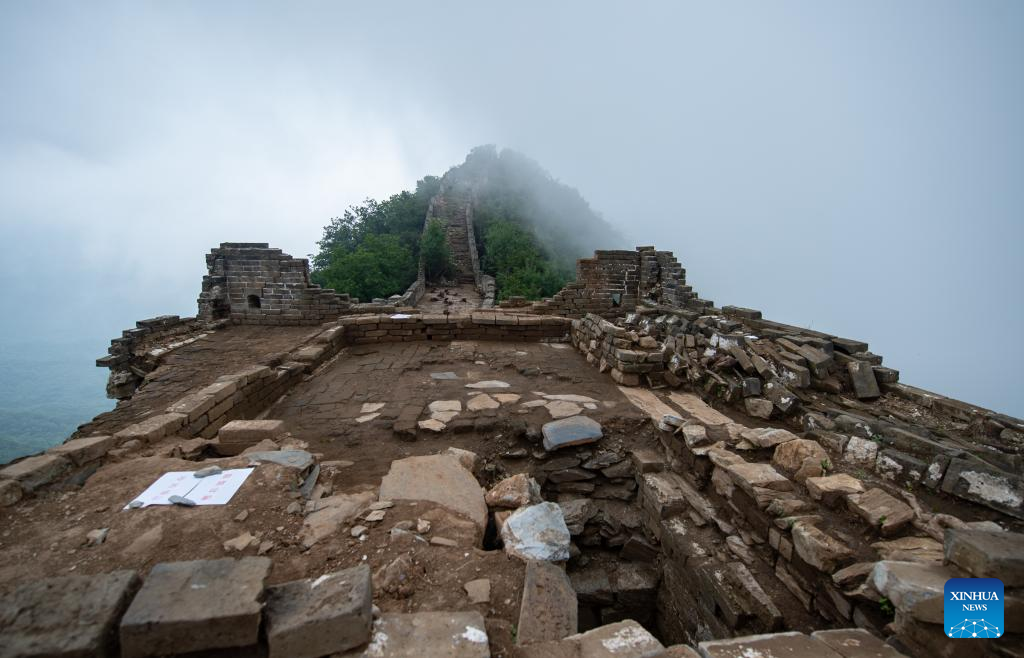
Photo taken on Aug. 17, 2022 shows a research-based restoration part of the Jiankou section of the Great Wall in Beijing, capital of China.
Located in Beijing's suburban Huairou District, the Jiankou section of the Great Wall, once known among the hikers as "the deserted Great Wall", is believed to be one of the most dangerous parts of the relic.
A restoration project, mainly focusing on a 1,678-meter-long wall with 8 watchtowers in the west part of Jiankou section, is expected to be completed by the end of October.
The project is implemented in adherence of the principle of "minimum intervention" to ensure maximum authenticity, integrity and ancient historical features of the Great Wall.
Meanwhile, a research-based restoration project is also underway with the aim of reinforcing and eliminating potential safety hazards as well as changes and existing conditions of the Great Wall through multidisciplinary cooperation. (Xinhua/Chen Zhonghao)

A worker cleans bricks at the research-based restoration part of the Jiankou section of the Great Wall in Beijing, capital of China, Aug. 17, 2022.
Located in Beijing's suburban Huairou District, the Jiankou section of the Great Wall, once known among the hikers as "the deserted Great Wall", is believed to be one of the most dangerous parts of the relic.
A restoration project, mainly focusing on a 1,678-meter-long wall with 8 watchtowers in the west part of Jiankou section, is expected to be completed by the end of October.
The project is implemented in adherence of the principle of "minimum intervention" to ensure maximum authenticity, integrity and ancient historical features of the Great Wall.
Meanwhile, a research-based restoration project is also underway with the aim of reinforcing and eliminating potential safety hazards as well as changes and existing conditions of the Great Wall through multidisciplinary cooperation. (Xinhua/Chen Zhonghao)
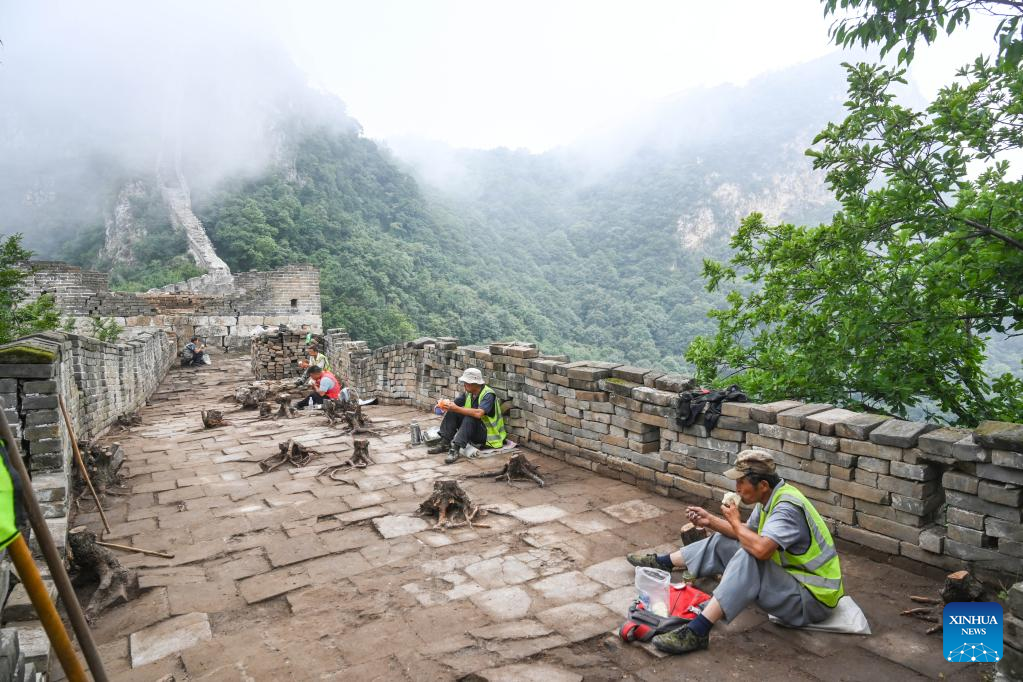
Workers have lunch at a research-based restoration part of the Jiankou section of the Great Wall in Beijing, capital of China, Aug. 17, 2022.
Located in Beijing's suburban Huairou District, the Jiankou section of the Great Wall, once known among the hikers as "the deserted Great Wall", is believed to be one of the most dangerous parts of the relic.
A restoration project, mainly focusing on a 1,678-meter-long wall with 8 watchtowers in the west part of Jiankou section, is expected to be completed by the end of October.
The project is implemented in adherence of the principle of "minimum intervention" to ensure maximum authenticity, integrity and ancient historical features of the Great Wall.
Meanwhile, a research-based restoration project is also underway with the aim of reinforcing and eliminating potential safety hazards as well as changes and existing conditions of the Great Wall through multidisciplinary cooperation. (Xinhua/Chen Yehua)
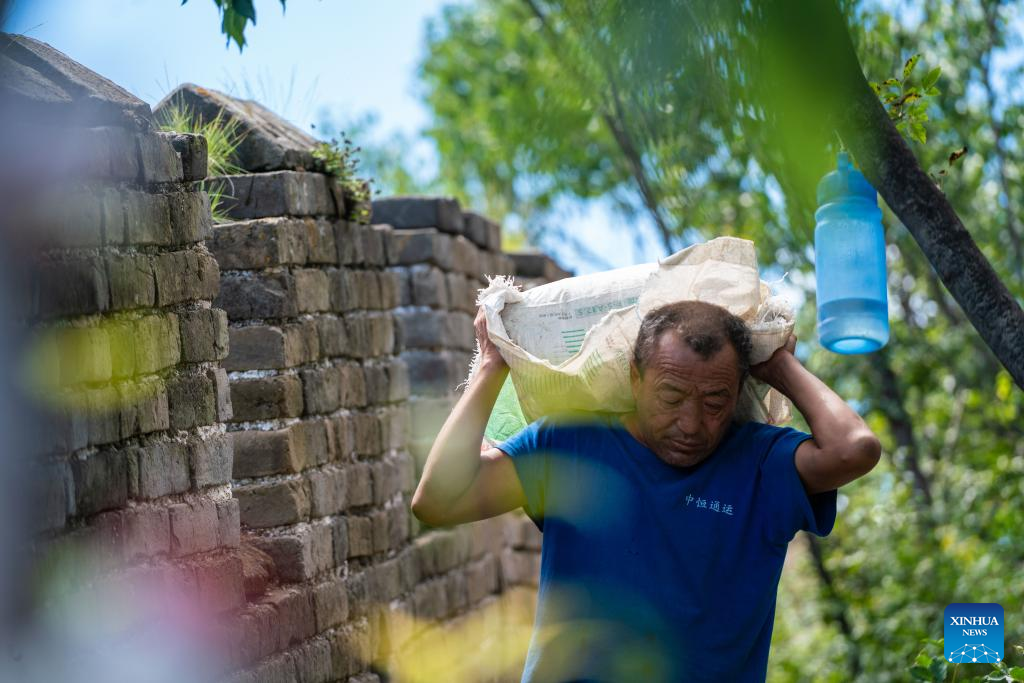
A worker carries restoration materials to a watchtower at the west part of Jiankou section of the Great Wall in Beijing, capital of China, Aug. 16, 2022.
Located in Beijing's suburban Huairou District, the Jiankou section of the Great Wall, once known among the hikers as "the deserted Great Wall", is believed to be one of the most dangerous parts of the relic.
A restoration project, mainly focusing on a 1,678-meter-long wall with 8 watchtowers in the west part of Jiankou section, is expected to be completed by the end of October.
The project is implemented in adherence of the principle of "minimum intervention" to ensure maximum authenticity, integrity and ancient historical features of the Great Wall.
Meanwhile, a research-based restoration project is also underway with the aim of reinforcing and eliminating potential safety hazards as well as changes and existing conditions of the Great Wall through multidisciplinary cooperation. (Xinhua/Li Jing)
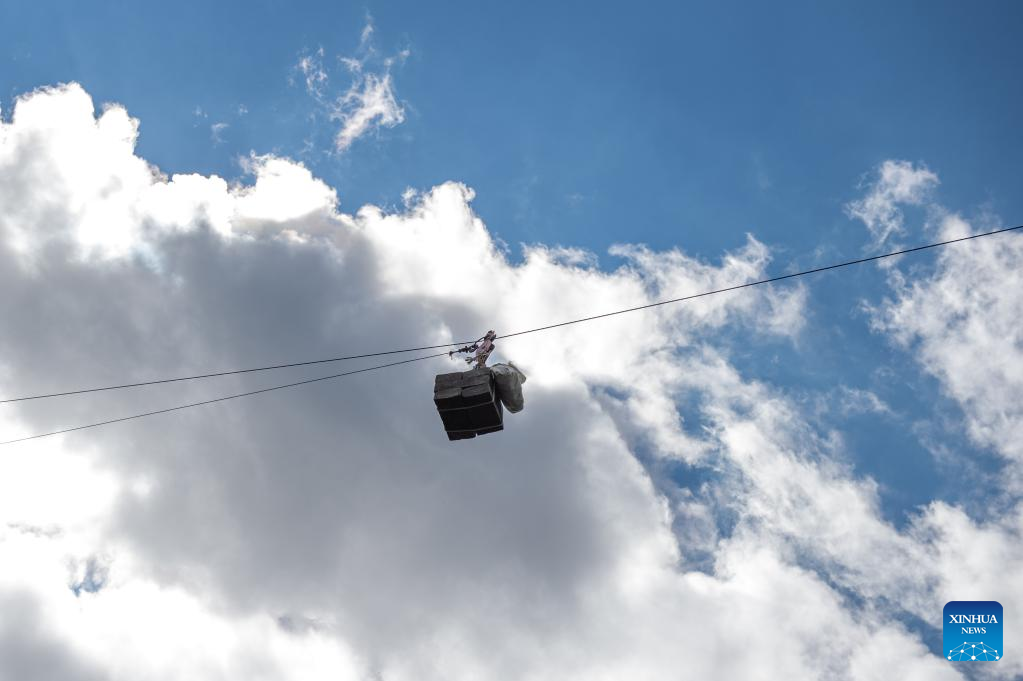
Restoration materials are transported via cableway at the Jiankou section of the Great Wall in Beijing, capital of China, Aug. 16, 2022.
Located in Beijing's suburban Huairou District, the Jiankou section of the Great Wall, once known among the hikers as "the deserted Great Wall", is believed to be one of the most dangerous parts of the relic.
A restoration project, mainly focusing on a 1,678-meter-long wall with 8 watchtowers in the west part of Jiankou section, is expected to be completed by the end of October.
The project is implemented in adherence of the principle of "minimum intervention" to ensure maximum authenticity, integrity and ancient historical features of the Great Wall.
Meanwhile, a research-based restoration project is also underway with the aim of reinforcing and eliminating potential safety hazards as well as changes and existing conditions of the Great Wall through multidisciplinary cooperation. (Xinhua/Chen Zhonghao)
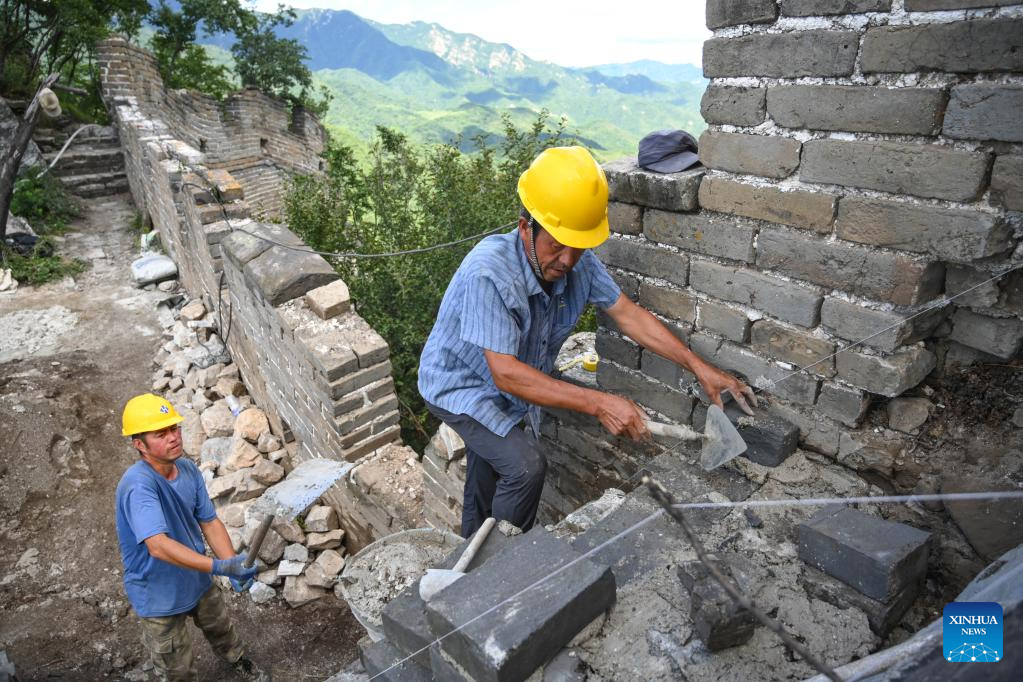
Workers lay bricks at the scenic spot "Beijing Knot" in the Jiankou section of the Great Wall in Beijing, capital of China, Aug. 16, 2022.
Located in Beijing's suburban Huairou District, the Jiankou section of the Great Wall, once known among the hikers as "the deserted Great Wall", is believed to be one of the most dangerous parts of the relic.
A restoration project, mainly focusing on a 1,678-meter-long wall with 8 watchtowers in the west part of Jiankou section, is expected to be completed by the end of October.
The project is implemented in adherence of the principle of "minimum intervention" to ensure maximum authenticity, integrity and ancient historical features of the Great Wall.
Meanwhile, a research-based restoration project is also underway with the aim of reinforcing and eliminating potential safety hazards as well as changes and existing conditions of the Great Wall through multidisciplinary cooperation. (Xinhua/Chen Yehua)
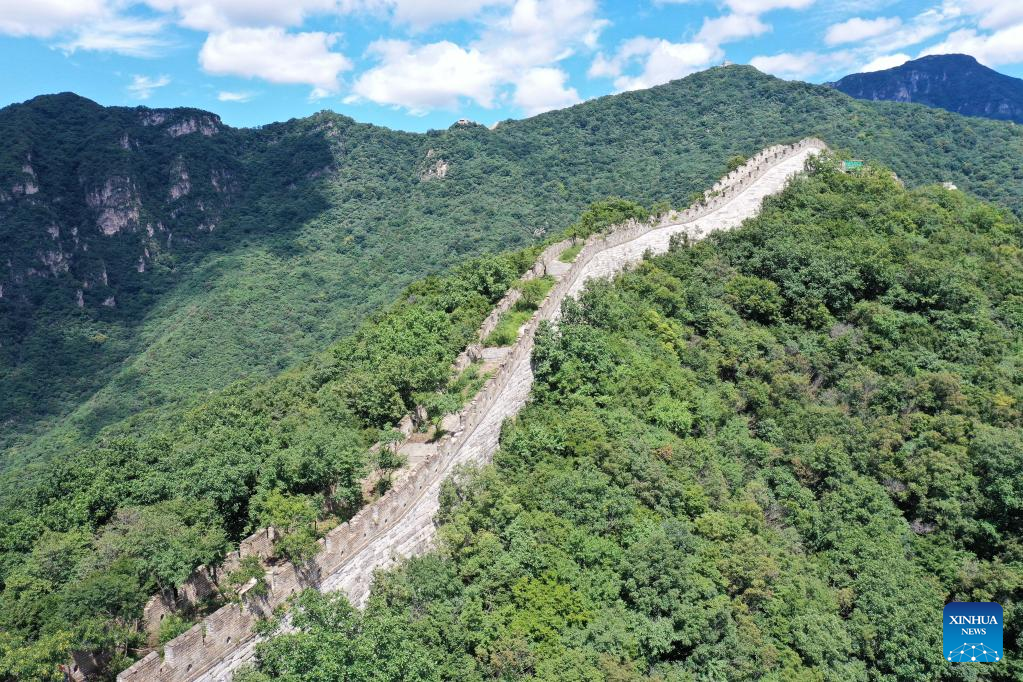
Aerial photo taken on Aug. 16, 2022 shows the west part of Jiankou section of the Great Wall in Beijing, capital of China.
Located in Beijing's suburban Huairou District, the Jiankou section of the Great Wall, once known among the hikers as "the deserted Great Wall", is believed to be one of the most dangerous parts of the relic.
A restoration project, mainly focusing on a 1,678-meter-long wall with 8 watchtowers in the west part of Jiankou section, is expected to be completed by the end of October.
The project is implemented in adherence of the principle of "minimum intervention" to ensure maximum authenticity, integrity and ancient historical features of the Great Wall.
Meanwhile, a research-based restoration project is also underway with the aim of reinforcing and eliminating potential safety hazards as well as changes and existing conditions of the Great Wall through multidisciplinary cooperation. (Xinhua/Chen Yehua)
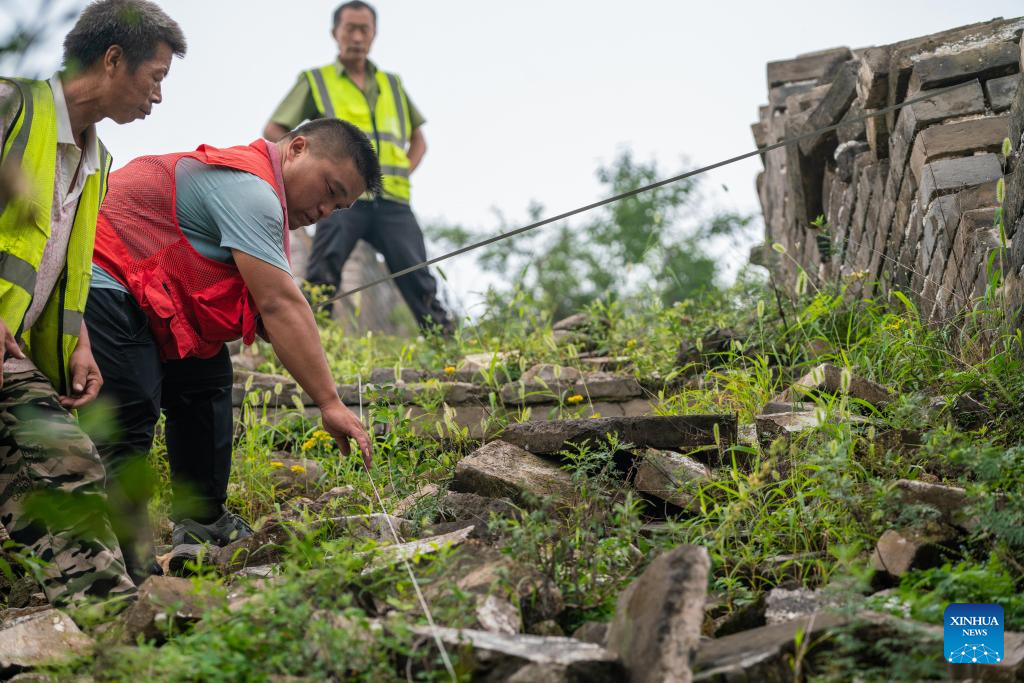
Technician Yang Zhanjie (C) demarcates the excavation area for archaeological purpose at the Jiankou section of the Great Wall in Beijing, capital of China, Aug. 17, 2022.
Located in Beijing's suburban Huairou District, the Jiankou section of the Great Wall, once known among the hikers as "the deserted Great Wall", is believed to be one of the most dangerous parts of the relic.
A restoration project, mainly focusing on a 1,678-meter-long wall with 8 watchtowers in the west part of Jiankou section, is expected to be completed by the end of October.
The project is implemented in adherence of the principle of "minimum intervention" to ensure maximum authenticity, integrity and ancient historical features of the Great Wall.
Meanwhile, a research-based restoration project is also underway with the aim of reinforcing and eliminating potential safety hazards as well as changes and existing conditions of the Great Wall through multidisciplinary cooperation. (Xinhua/Li Jing)

Media professionals cover the new archeological discoveries at the research-based restoration part of the Jiankou section of the Great Wall in Beijing, capital of China, Aug. 17, 2022.
Located in Beijing's suburban Huairou District, the Jiankou section of the Great Wall, once known among the hikers as "the deserted Great Wall", is believed to be one of the most dangerous parts of the relic.
A restoration project, mainly focusing on a 1,678-meter-long wall with 8 watchtowers in the west part of Jiankou section, is expected to be completed by the end of October.
The project is implemented in adherence of the principle of "minimum intervention" to ensure maximum authenticity, integrity and ancient historical features of the Great Wall.
Meanwhile, a research-based restoration project is also underway with the aim of reinforcing and eliminating potential safety hazards as well as changes and existing conditions of the Great Wall through multidisciplinary cooperation. (Xinhua/Chen Yehua)
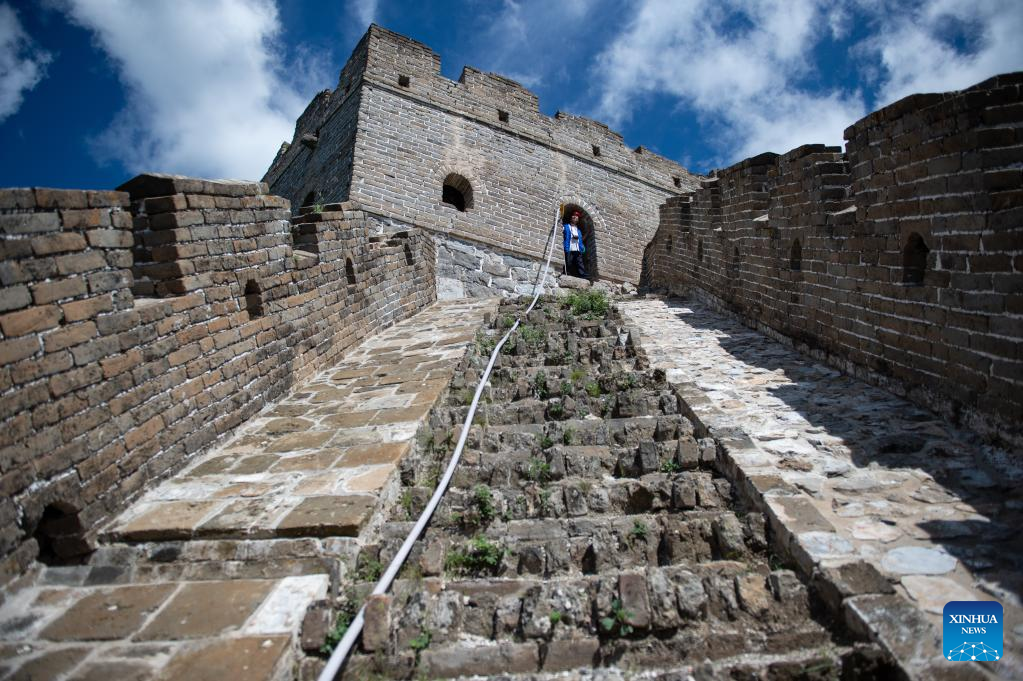
Engineer Cheng Yongmao stands at a watchtower of the west part of Jiankou section of the Great Wall in Beijing, capital of China, Aug. 16, 2022.
Located in Beijing's suburban Huairou District, the Jiankou section of the Great Wall, once known among the hikers as "the deserted Great Wall", is believed to be one of the most dangerous parts of the relic.
A restoration project, mainly focusing on a 1,678-meter-long wall with 8 watchtowers in the west part of Jiankou section, is expected to be completed by the end of October.
The project is implemented in adherence of the principle of "minimum intervention" to ensure maximum authenticity, integrity and ancient historical features of the Great Wall.
Meanwhile, a research-based restoration project is also underway with the aim of reinforcing and eliminating potential safety hazards as well as changes and existing conditions of the Great Wall through multidisciplinary cooperation. (Xinhua/Chen Zhonghao)
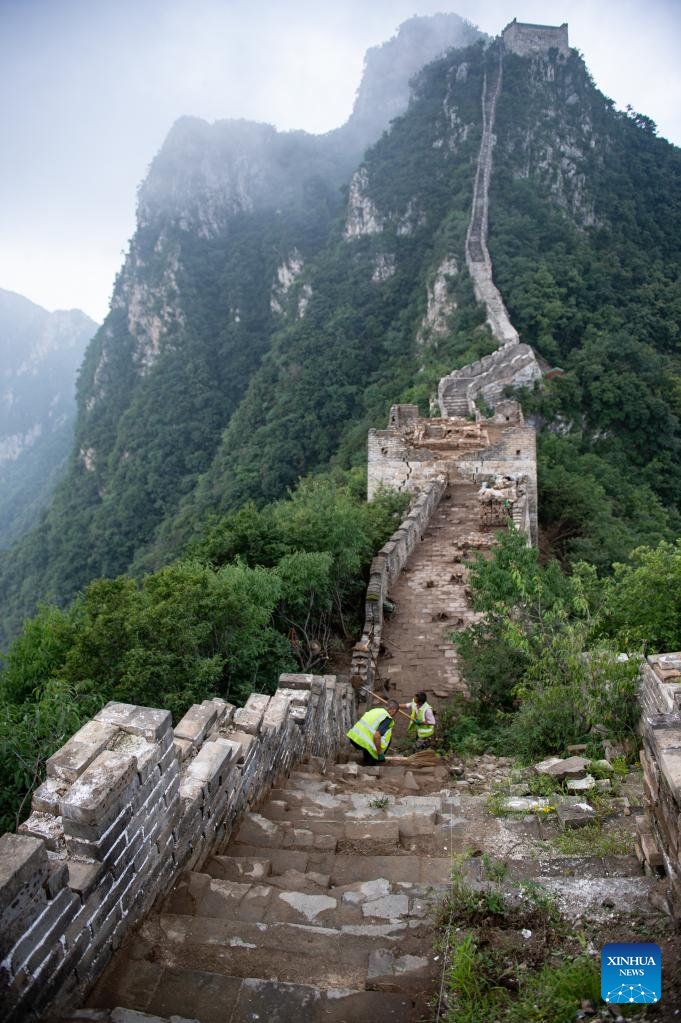
Workers excavate the area for archaeological purpose at the research-based restoration part of the Jiankou section of the Great Wall in Beijing, capital of China, Aug. 17, 2022.
Located in Beijing's suburban Huairou District, the Jiankou section of the Great Wall, once known among the hikers as "the deserted Great Wall", is believed to be one of the most dangerous parts of the relic.
A restoration project, mainly focusing on a 1,678-meter-long wall with 8 watchtowers in the west part of Jiankou section, is expected to be completed by the end of October.
The project is implemented in adherence of the principle of "minimum intervention" to ensure maximum authenticity, integrity and ancient historical features of the Great Wall.
Meanwhile, a research-based restoration project is also underway with the aim of reinforcing and eliminating potential safety hazards as well as changes and existing conditions of the Great Wall through multidisciplinary cooperation. (Xinhua/Chen Zhonghao)
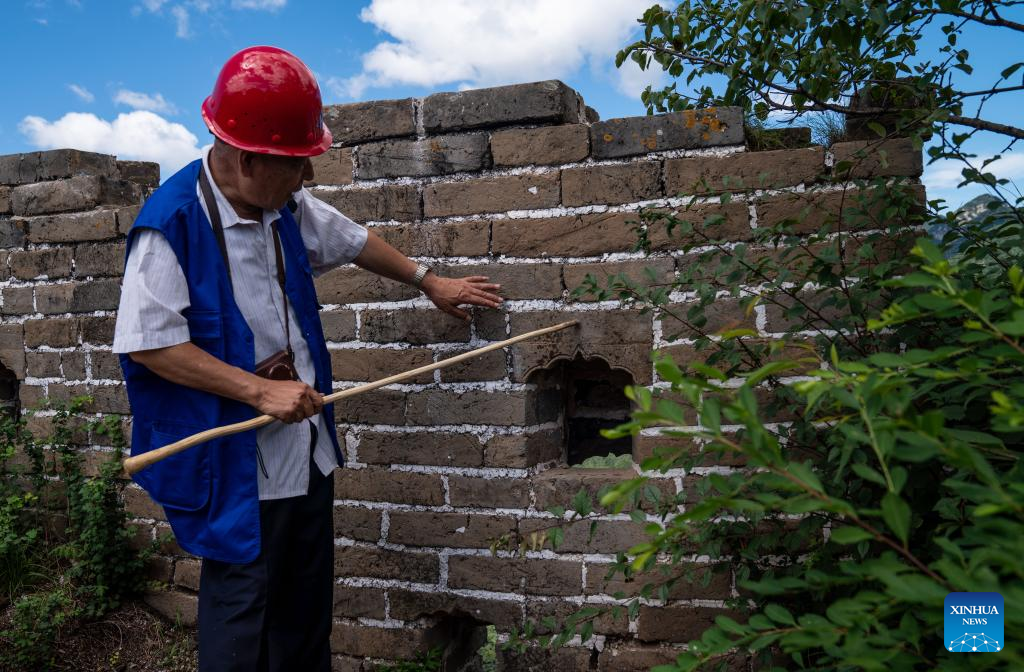
Engineer Cheng Yongmao explains the bricks at the Jiankou section of the Great Wall in Beijing, capital of China, Aug. 16, 2022.
Located in Beijing's suburban Huairou District, the Jiankou section of the Great Wall, once known among the hikers as "the deserted Great Wall", is believed to be one of the most dangerous parts of the relic.
A restoration project, mainly focusing on a 1,678-meter-long wall with 8 watchtowers in the west part of Jiankou section, is expected to be completed by the end of October.
The project is implemented in adherence of the principle of "minimum intervention" to ensure maximum authenticity, integrity and ancient historical features of the Great Wall.
Meanwhile, a research-based restoration project is also underway with the aim of reinforcing and eliminating potential safety hazards as well as changes and existing conditions of the Great Wall through multidisciplinary cooperation. (Xinhua/Li Jing)
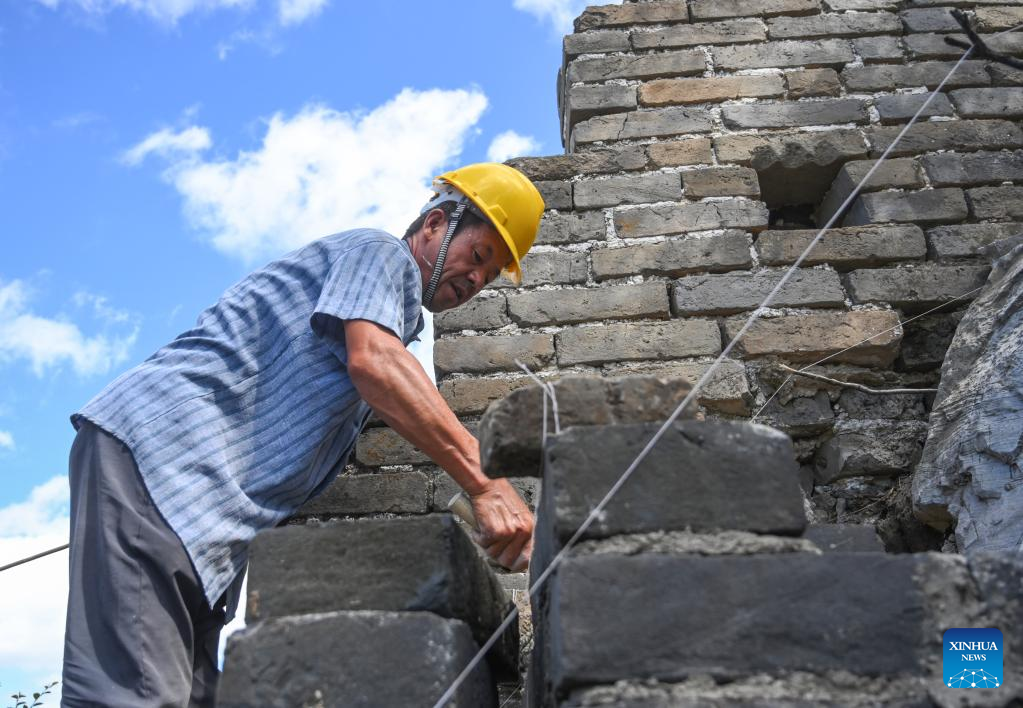
A worker lays bricks at the scenic spot "Beijing Knot" in the Jiankou section of the Great Wall in Beijing, capital of China, Aug. 16, 2022.
Located in Beijing's suburban Huairou District, the Jiankou section of the Great Wall, once known among the hikers as "the deserted Great Wall", is believed to be one of the most dangerous parts of the relic.
A restoration project, mainly focusing on a 1,678-meter-long wall with 8 watchtowers in the west part of Jiankou section, is expected to be completed by the end of October.
The project is implemented in adherence of the principle of "minimum intervention" to ensure maximum authenticity, integrity and ancient historical features of the Great Wall.
Meanwhile, a research-based restoration project is also underway with the aim of reinforcing and eliminating potential safety hazards as well as changes and existing conditions of the Great Wall through multidisciplinary cooperation. (Xinhua/Chen Yehua)
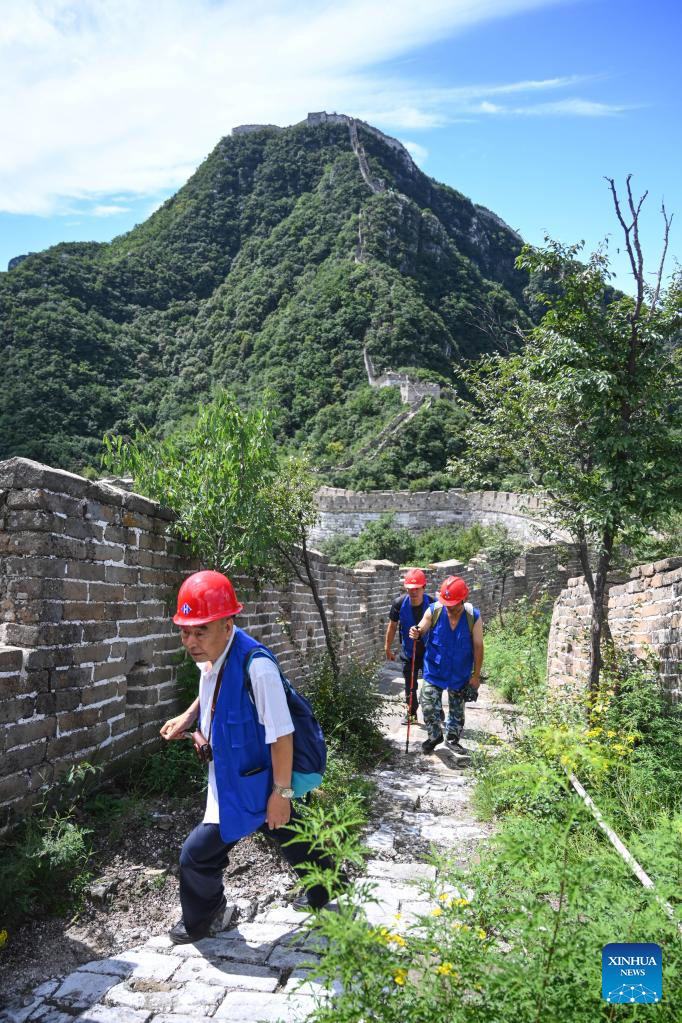
Engineer Cheng Yongmao (front) and his colleagues walk towards a restoration site of the west part of the Jiankou section of the Great Wall in Beijing, capital of China, Aug. 16, 2022.
Located in Beijing's suburban Huairou District, the Jiankou section of the Great Wall, once known among the hikers as "the deserted Great Wall", is believed to be one of the most dangerous parts of the relic.
A restoration project, mainly focusing on a 1,678-meter-long wall with 8 watchtowers in the west part of Jiankou section, is expected to be completed by the end of October.
The project is implemented in adherence of the principle of "minimum intervention" to ensure maximum authenticity, integrity and ancient historical features of the Great Wall.
Meanwhile, a research-based restoration project is also underway with the aim of reinforcing and eliminating potential safety hazards as well as changes and existing conditions of the Great Wall through multidisciplinary cooperation. (Xinhua/Chen Yehua)



